

The University News

Why Three Day Weekends are Beneficial To Student’s Mental Health
Sophie Gloriod | November 18, 2021
Everyone knows the stress that school brings. Whether you are currently a student, or graduated last year or 50 years ago, we all remember feeling overwhelmed and lost in piles upon piles of homework. More often than not, students feel that professors do not remember being a student and feeling these negative emotions. When students, especially younger students, find themselves feeling overwhelmed and lost academically, it can lead to them feeling those same emotions in other aspects of their life. This can negatively affect their mental health, causing them to feel even more stress.
College students are expected to juggle academics, navigating a new town, making new friends, living on their own for the first time and figuring out exactly who they want to be. On top of all of this, they usually have 15 hours of class time, not including the homework they must complete outside of class. The homework is usually much more complicated than the work done in class, and due to the large class sizes, professors are often not able to work closely with their students, leaving them feeling lost and alienated in the classroom.
All week, students look forward to the weekend as an escape from the busyness of the week. The weekend brings sleeping in and having free time to pursue activities they actually enjoy. However, more often than not, students spend most of the day Saturday and Sunday doing homework and chores. After sleeping in in an attempt to regain some of the lost sleep from the earlier week, students must focus on getting their homework, projects and exam prep completed. Not only are these days taken up from catching up from the previous week’s homework, but also attempting to get ahead for the upcoming week to prevent them from becoming overwhelmed. However, doing this takes up most of the weekend, leaving no time to relax and socialize with friends.
Back in September, SLU decided to cancel classes on a Friday, giving students a long weekend to try and help them improve their mental health. The administration had the right idea; giving students more time off does give them more time to complete their work and have time to themselves. However, one three-day weekend every month or so does not do much for their overall mental health. While every Friday does not need to be a day off, cancelling Friday or Monday classes more frequently will help students improve their time management skills, as well as better their mental health.
Having a three-day weekend lets students break up their work over three days instead of two. Hypothetically, if students use Friday to socialize and take some time to themselves, they can use Saturday to run errands and clean their living spaces, leaving Sunday to do homework and prep for the upcoming week. It also allows students to be able to sleep in on three days instead of just two. It is a proven fact that more sleep increases focus and overall health. Feeling well-rested also helps students stay motivated and helps them actually comprehend and understand what they are learning, instead of just memorizing for the exam.
Giving students a three-day weekend more often encourages them to prioritize their mental health. Especially nowadays, students feel that they are only worth love and respect if they excel in all of their classes. They do not feel encouraged to live in the moment and enjoy such an influential period of their life: college. Students are worth more than their grades; they are not at university to work themselves to death. They should feel encouraged to do their best and work hard, but not feel that they must sacrifice everything in order to succeed or earn an A in a class.
In the end, grades will change and in five years, no one is going to care if you aced or failed one paper. The health of students should be prioritized, mental health. If universities like SLU feel their students’ mental health is declining, they should take action. SLU felt a three-day weekend would be beneficial to improving mental health. Therefore, three-day weekends should become normalized. They should not be seen as a “break,” nor should professors be allowed to assign work over these days off. Giving students a three-day weekend will increase their free time, allowing them to practice better time management skills and improve their mental health.
Your donation will support the student journalists of Saint Louis University. Your contribution will help us cover our annual website hosting costs.

Decoding the Pentagon’s ongoing audit deficiencies

A love letter to the Alamo Drafthouse

In defense of Pete Rose

Are you confident?
- Letters to the Editor
An open letter to SLU administration
How lonely are SLU students?

Arts & Life
Three romance books for oblivious boyfriends

Election 2024:
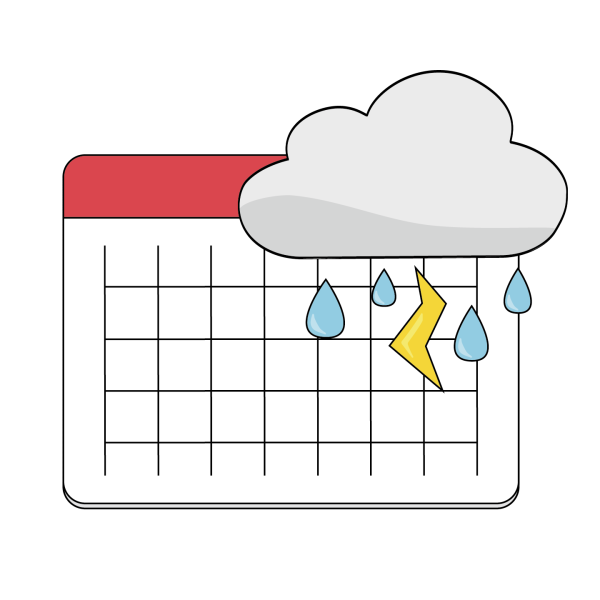
A rest-free April:

When, not if
The Student News Site of Saint Louis University
- Study Abroad
- Puzzle Solutions
- Advice Column
- Advertising
- Commenting Policy
- Rights and Permission
- Privacy Policy
- Saint Louis University: A Community In Mourning
- 2020 Election
- State of the University
- It’s Been a Year
Comments (13)
Cancel reply
Your email address will not be published. Required fields are marked *
BS • Mar 21, 2024 at 1:03 pm
Add more for younger students not JUST collage students.
brayan hernadez • Jan 26, 2024 at 11:09 am
CAN YOU ADD MORE THINGS THAT HELP STUDENTS
Lucy • Jun 7, 2023 at 7:25 pm
I found this helpful.
vito • May 10, 2023 at 2:21 pm
i love how they wrote this, this is so true
jonny • May 3, 2023 at 8:37 pm
hi this really help to inspire me
Catherine • Feb 19, 2023 at 7:13 pm
This was inspiring
LilyB • Jan 26, 2023 at 12:15 pm
this is great it should be sent to the board of education let us be off on Wednesday like a mid-week break
AndyA • Feb 19, 2023 at 1:34 pm
Totally agree with that.
EvieW • Mar 13, 2023 at 3:50 pm
I agree that this is great but then again the whole point of this argument is that it gives us a 3 day weekend. If it’s in the middle it’ll be hard to have to keep transitioning so quickly.
Derek Melvin • Sep 28, 2022 at 7:59 am
I think this is good because kids wont be glued to the comuters
Rayyan Hussain • Aug 27, 2022 at 6:21 pm
I think they should be 3 days of the weekends for students first of all it is very good for mental health for the students and not only for health also for religious reasons Muslims have a really special prayer on Fridays which they have to normally miss every Friday because of school so the Muslim students will be able to read the their important prayers on Friday which is very good so I think this is beneficial for students which it should be a thing.
Kittyluv2022 • Apr 21, 2022 at 10:00 pm
I love this article
MarioDaPimp♂️ • Mar 14, 2022 at 2:10 am
- Future Students
- Current Students
- Faculty/Staff

News and Media
- News & Media Home
- Research Stories
- School's In
- In the Media
You are here
More than two hours of homework may be counterproductive, research suggests.

A Stanford education researcher found that too much homework can negatively affect kids, especially their lives away from school, where family, friends and activities matter. "Our findings on the effects of homework challenge the traditional assumption that homework is inherently good," wrote Denise Pope , a senior lecturer at the Stanford Graduate School of Education and a co-author of a study published in the Journal of Experimental Education . The researchers used survey data to examine perceptions about homework, student well-being and behavioral engagement in a sample of 4,317 students from 10 high-performing high schools in upper-middle-class California communities. Along with the survey data, Pope and her colleagues used open-ended answers to explore the students' views on homework. Median household income exceeded $90,000 in these communities, and 93 percent of the students went on to college, either two-year or four-year. Students in these schools average about 3.1 hours of homework each night. "The findings address how current homework practices in privileged, high-performing schools sustain students' advantage in competitive climates yet hinder learning, full engagement and well-being," Pope wrote. Pope and her colleagues found that too much homework can diminish its effectiveness and even be counterproductive. They cite prior research indicating that homework benefits plateau at about two hours per night, and that 90 minutes to two and a half hours is optimal for high school. Their study found that too much homework is associated with: • Greater stress : 56 percent of the students considered homework a primary source of stress, according to the survey data. Forty-three percent viewed tests as a primary stressor, while 33 percent put the pressure to get good grades in that category. Less than 1 percent of the students said homework was not a stressor. • Reductions in health : In their open-ended answers, many students said their homework load led to sleep deprivation and other health problems. The researchers asked students whether they experienced health issues such as headaches, exhaustion, sleep deprivation, weight loss and stomach problems. • Less time for friends, family and extracurricular pursuits : Both the survey data and student responses indicate that spending too much time on homework meant that students were "not meeting their developmental needs or cultivating other critical life skills," according to the researchers. Students were more likely to drop activities, not see friends or family, and not pursue hobbies they enjoy. A balancing act The results offer empirical evidence that many students struggle to find balance between homework, extracurricular activities and social time, the researchers said. Many students felt forced or obligated to choose homework over developing other talents or skills. Also, there was no relationship between the time spent on homework and how much the student enjoyed it. The research quoted students as saying they often do homework they see as "pointless" or "mindless" in order to keep their grades up. "This kind of busy work, by its very nature, discourages learning and instead promotes doing homework simply to get points," said Pope, who is also a co-founder of Challenge Success , a nonprofit organization affiliated with the GSE that conducts research and works with schools and parents to improve students' educational experiences.. Pope said the research calls into question the value of assigning large amounts of homework in high-performing schools. Homework should not be simply assigned as a routine practice, she said. "Rather, any homework assigned should have a purpose and benefit, and it should be designed to cultivate learning and development," wrote Pope. High-performing paradox In places where students attend high-performing schools, too much homework can reduce their time to foster skills in the area of personal responsibility, the researchers concluded. "Young people are spending more time alone," they wrote, "which means less time for family and fewer opportunities to engage in their communities." Student perspectives The researchers say that while their open-ended or "self-reporting" methodology to gauge student concerns about homework may have limitations – some might regard it as an opportunity for "typical adolescent complaining" – it was important to learn firsthand what the students believe. The paper was co-authored by Mollie Galloway from Lewis and Clark College and Jerusha Conner from Villanova University.
Clifton B. Parker is a writer at the Stanford News Service .
More Stories
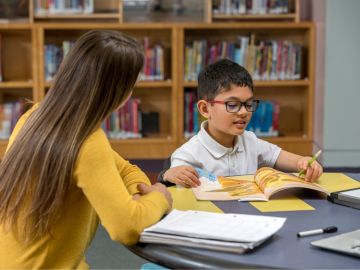
⟵ Go to all Research Stories
Get the Educator
Subscribe to our monthly newsletter.
Stanford Graduate School of Education
482 Galvez Mall Stanford, CA 94305-3096 Tel: (650) 723-2109
- Contact Admissions
- GSE Leadership
- Site Feedback
- Web Accessibility
- Career Resources
- Faculty Open Positions
- Explore Courses
- Academic Calendar
- Office of the Registrar
- Cubberley Library
- StanfordWho
- StanfordYou
Improving lives through learning

- Stanford Home
- Maps & Directions
- Search Stanford
- Emergency Info
- Terms of Use
- Non-Discrimination
- Accessibility
© Stanford University , Stanford , California 94305 .

The Caravan
Students shouldn’t have homework on weekends.
Jonathan Kuptel '22 , Staff Writer | November 7, 2021

Jonathan Kuptel
MC senior Imari Price works on a assignment for 21st-Century Media class.
Teachers and students have different opinions about homework. Saying it is not fair is the usual argument, but being fair is not the issue. It is about students being prepared. Daily homework assignments can be difficult, and weekends homework assignments are worse. Students operate best when they are well-rested and ready to go. A weekend with no homework would help them to be fresh and ready on Monday morning. Weekend assignments tend to be longer and more difficult.
The students have a difficult day with classes, practices, and going to school. By Friday, (test day) they are near exhaustion. Most tests are given on Fridays. Homework on Monday-Thursday is time-consuming. Some weekends will include assignments in more than 1 class. Those who go to Mount Carmel are near the end of their rope by 2:40 PM on Friday. I have had other discussions with the senior class and we all feel pretty tired at the end of the day at 2:40 PM. A free weekend helps to get prepared for the next grind to start. No homework weekends assures better sleep cycles and a body that has recovered and refreshed. Weekends include chores around the house and family commitments. This plus weekends assignments lead to a lack of sleep. This means Monday will have a positive attitude. No homework on weekends also means more family time. This is a bonus.
Alfie Kohn in his book The Homework Myth: Why Are Kids Get Too Much Of A Bad Thing says, “There is no evidence to demonstrate that homework benefits students.” The homework on weekends starts in elementary school and continues throughout high school.
Mr. Kohn states that homework on weekends starts in elementary school and continues throughout high school. This supports the argument that weekend homework starts in elementary school and now students at Mount Carmel High School have to deal with weekend assignments. The weekend assignments take too much time and are a waste of students’ time.
Nancy Kalish , author of The Case Against Homework: How Homework Is Hurting Our Children And What We Can Do About It, says “simply busy work” makes learning “a chore rather than a positive, constructive experience.”
Receiving weekend homework that is not discussed in class and counts only as “busy work” is counterproductive. Students finish the assignments because they are required to be done. When the homework is not reviewed on Monday, it leads to frustration. Busy homework that serves no purpose is never a good idea.
Gerald LeTender of Penn State’s Education Policy Studies Department points out the “shotgun approach to homework when students receive the same photocopied assignment which is then checked as complete rather than discussed is not very effective.” Some teachers discuss the homework assignments and that validates the assignment. Some teachers however just check homework assignments for completion. LeTender goes on to say, “If there’s no feedback and no monitoring, the homework is probably not effective.” Researchers from the Curry School of Education at the University of Virginia had similar findings in their study “ When Is Homework Worth The Time?” Researchers reported no substantive difference in the grades of students who had homework completion. Adam Maltese, a researcher , noted , “Our results hint that maybe homework is not being used as well as it could be. Even one teacher who assigns busy shotgun homework is enough to be a bad idea.
Students come to know when homework is the “shotgun approach.” They find this kind of assignment dull. Students have no respect for assignments like this. Quality assignments are appreciated by students.
Etta Kralovec and John Buell in their book How Homework Disrupts Families, Overburdens Children, And Limits Learning assert that homework contributes to a corporate style, competitive U.S. culture that overvalued work to the detriment of personal and familial well being. They go on to call for an end to homework, but to extend the school day.
Cooper, Robinson, and Patalc, in 2006 warned that homework could become counter productive. Homework is counterproductive when it is a (shotgun) assignment. To reiterate, not all homework is bad. Bad homework which is not reviewed in class just plain “busy work” is not positive and could be counterproductive.
Sara Croll, Literacy Coach and Author, believes too much homework causes stress for students. Diana Stelin, teacher, artist, and mother says, “I’m absolutely in favor of this ban. Homework is homework, it doesn’t matter what class it comes from. What it does is create negative associations in students of all ages, takes away their innate desire to learn, and makes the subject a dreaded chore.”
When students come to dread their homework, they do not do a great job on these assignments. Making students do a lot of homework isn’t beneficial because they get drowsy when they work at it for hours and hours at a time. It is hard for the brain to function properly when it is tired and boring.
Pat Wayman, Teacher and CEO of HowtoLearn.com says, “Many kids are working as many hours as their overscheduled parents and it is taking a toll.” “Their brains and their bodies need time to be curious, have fun, be creative and just be a kid.”
No homework on weekends is not just a wish, but it is supported by all of these educators and authors. They all champion limiting homework are totally opposed to homework assignments. Educators and students agree that no homework on weekends is a good idea. Meaningful homework, a longer school day, and discussion of homework are what these educators and authors encourage.

My dreaded, but also rewarding, junior year

Appreciating some of MC’s most dedicated workers

Surrounded by my brothers: a senior reflection

Is it time to eliminate class rankings?
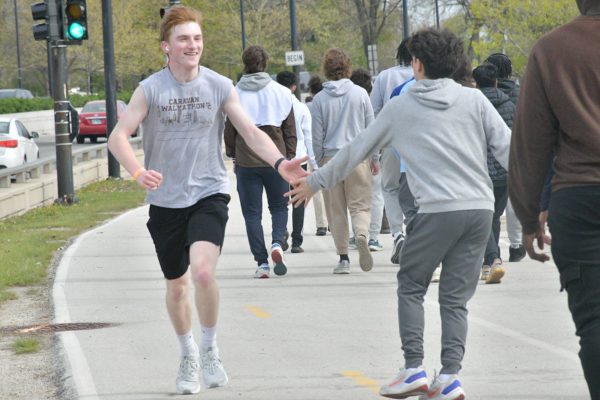
Running a 10k for the first time alongside my brothers
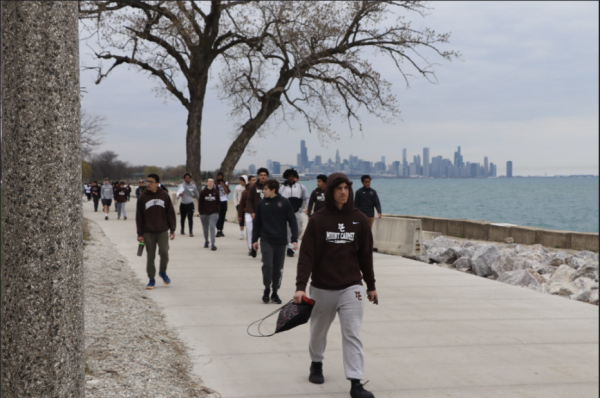
Straggling students need to step up for Walkathon fundraising

Mount Carmel benefits from trimesters
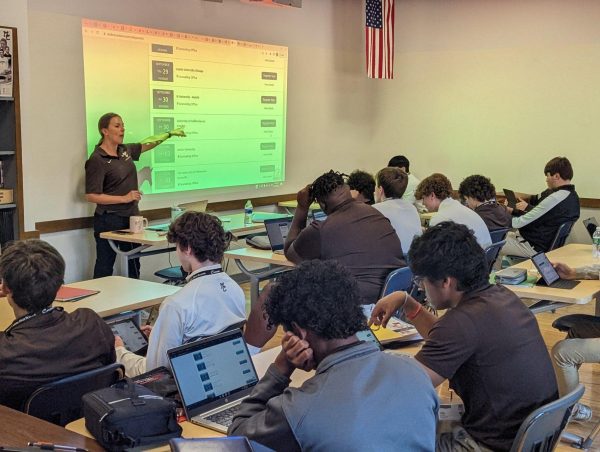
Students would benefit from financial planning, life skills
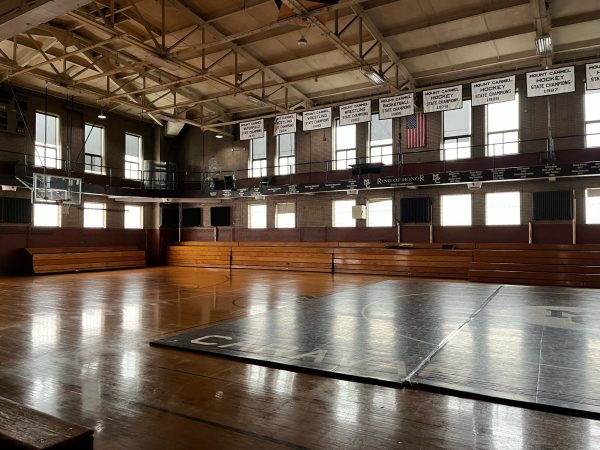
Nothing beats events in the Alumni Gym

MLK exemplified the values of Mt. Carmel
The student news site of Mount Carmel High School
- Journalism at Mount Carmel
- pollsarchive
- Sports Center

- Special Issues
- Conferences
- Turkish Journal of Analysis and Number Theory Home
- Current Issue
- Browse Articles
- Editorial Board
- Abstracting and Indexing
- Aims and Scope
- American Journal of Educational Research Home
- Social Science
- Medicine & Healthcare
- Earth & Environmental
- Agriculture & Food Sciences
- Business, Management & Economics
- Biomedical & Life Science
- Mathematics & Physics
- Engineering & Technology
- Materials Science & Metallurgy
- Quick Submission
- Apply for Editorial Position
- Propose a special issue
- Launch a new journal
- Authors & Referees
- Advertisers
- Open Access
- Full-Text PDF
- Full-Text HTML
- Full-Text Epub
- Full-Text XML
- Panos Petratos, Daniel Herrera, Emre Soydemir. Academic Success and Weekend Study Time: Further Evidence from Public Elementary School Students. American Journal of Educational Research . Vol. 9, No. 2, 2021, pp 67-71. https://pubs.sciepub.com/education/9/2/2 ">Normal Style
- Petratos, Panos, Daniel Herrera, and Emre Soydemir. 'Academic Success and Weekend Study Time: Further Evidence from Public Elementary School Students.' American Journal of Educational Research 9.2 (2021): 67-71. ">MLA Style
- Petratos, P. , Herrera, D. , & Soydemir, E. (2021). Academic Success and Weekend Study Time: Further Evidence from Public Elementary School Students. American Journal of Educational Research , 9 (2), 67-71. ">APA Style
- Petratos, Panos, Daniel Herrera, and Emre Soydemir. 'Academic Success and Weekend Study Time: Further Evidence from Public Elementary School Students.' American Journal of Educational Research 9, no. 2 (2021): 67-71. ">Chicago Style
Academic Success and Weekend Study Time: Further Evidence from Public Elementary School Students
While there is general belief that students who study during weekends is more likely to succeed academically, empirical evidence on this postulation happens to be very limited in the extant literature. We provide evidence on this postulated association between academic success, and weekend study time by comparing responses from public elementary school students. A Survey is conducted for fifth and sixth grade students who are happen to be more mature relative to prior grade school students. The findings show that in general weekend study time is positively associated with greater academic success. We also examine the role of parental support and find that parental support leads to less weekend study time. The findings are consistent with the view that weekend study time results in greater academic success and parental support creates more free time for students during weekends.
1. Introduction
While there is general belief that students who study during weekends is more likely to succeed academically, empirical evidence on this postulation happens to be very limited in the extant literature. Particularly, there is not enough evidence on the amount of hours a student needs to study during weekends to reap the highest productivity. Weekend study time varies greatly among elementary school students. While there is some evidence on parental involvement, the association between academic success and weekend study time is less obvious. In this paper, we provide further evidence by investigating whether academic success is associated with weekend study time. In particular, a survey is conducted to examine the postulated association by comparing survey responses from fifth and sixth grade students.
There appears to be several distinct results that contribute to the existing literature. First, the findings show that greater academic success is associated with weekend study time. Greater academic success is reported for students who study more than one hour across the board in all subjects. Students tend to do better in mostly in ELA subject and least in science subject with weekend studying. Consequently sixth graders report studying more during weekends than 5 th graders. Studying less than one hour does not lead to any significant results between self-reported grade point average for all of the subjects. Lastly, parental involvement leads to less weekend study.
The findings are consistent with the view that academic success is associated with greater focus as depicted by the length of studying of at least more than one hour. Less weekend study time results from parental involvement. The findings are also consistent with the view that kids with parental involvement have more free time during weekends.
The remainder of this study is structured as follows. Section two presents the literature review, section three describes data and methodology, section four reports findings and section six concludes.
2. Review of Literature
Erdogdu et al 1 examine factors associated with academic success. They find that access to internet, students’ possession of his/her own room in the house, parents’ education levels, students’ native language, school size and student per teacher ratio all have an effect on academic success.
Bahar et al 2 examine the impact of sociometric status and other correlates association with academic success. Bahar finds that gender, family, perceived social support from someone special to be meaningful predictors of academic success.
Calcagno et al 3 looks at institutional predictors of academic success. The study finds negative association with relatively large institutional size, proportion of part time faculty and minority students.
Erten and Burden 4 investigate to what extent do 6 th grade students attribute their performance in a school based achievement test. They find that ability attribution, interest attribution and teacher attribution to be the best predictors of test performance.
Pong 5 examines schools with greater concentrations of students who have single parent and stepfamilies. The study finds that schools that are predominated by students from single parent families and stepfamilies negatively affect their students’ achievement even after controlling for individual demographic characteristics and family background. This negative effect is attributed to low socioecomic status of single parent families and stepfamilies.
In this study we keep other factors constant and focus on the little examined association between weekend study time and academic success. The following hypotheses are tested in investigating the postulated association between parental involvement and weekend study time. First hypotheses conjectures that parental involvement for GATE students is associated with less weekend study time and greater academic achievement. Second hypothesis null statement is that Math, Science and ELA grades are higher with less weekend study time for NON-GATE students with parental support. Last hypothesis null statement is that the Math, Science and ELA grades are better for GATE students than non-GATE students both with parental support.
3. Data and Methodology
The survey was constructed using quantifiable questions. Thus, open ended questions were avoided. Surveys were administered anonymously. Surveys were printed and distributed by hand to fifth and sixth grade student population enrolled at Julien Elementary School. A Survey construction software 6 is used to enter survey data in digital format. Google spreadsheet was used to conduct statistical analysis to measure responses such as how self-reported student grades in Math, Science and ELA subjects are associated with parental involvement and without parental involvement in projects and homework. The dependent variables were, math grades, ELA grades and Science grades. Independent Variables were, weekend study time, parental involvement, gender, hours spent, GATE (gifted and talented education) and non-GATE distinction. Weekend study time was asked in categories that show hourly intervals from zero to five hours and more. Among 277 surveys that are printed, 238 surveys are collected and entered on the spreadsheet
4. Empirical Findings
GATE students who reported receiving parental involvement constituted 78 percent of the entire GATE student cohort. However, non-gate students who reported receiving parental involvement constituted 84 percent of the entire non-gate student cohort. Thus, a higher percentage of non-gate students reported receiving more parental involvement than gate students. This finding is consistent with the view that gate students perhaps need less parental involvement to achieve academic success than non-gate students.
Table 1 reports weekend study time and average self-reported grade point average for 5 th and 6 th grade math, science and ELA subjects. Non-GATE students who do not report studying during weekends appear to have a lower self-reported grade point average than those students who report studying during weekends. The picture is a bit more complex for GATE students. Interestingly, GATE students who report not studying during weekends appear to have a higher self-reported grade point average than those students who report studying during weekends. Perhaps the former cohort is subject to a different level of peer pressure or they spend more hours during studying during week days. Another explanation may be that these students have more parental support that removes the need to study during weekends.
Table 1. 5 th and 6 th Grade Weekend Study Time and Self-reported subject GPA

- Tables index View option Full Size Next Table
Table 2 reports average weekend study time for fifth and sixth grade non-GATE and GATE students. The responses reveal that non-GATE 5 th grade students spend on average 39 minutes studying during weekends. The study time is longer for 6th grade students who report studying on average 41 minutes. GATE students in 5 th grade report studying on average 53 minutes, longer that non-GATE 5 th grade students. Non-GATE 6 th grade students report studying on average 41 minutes. Thus they appear to study a bit longer than 5 th grade non-GATE students. GATE 6 th grade students report studying on average 1 hour and 8 minutes, longer than non-GATE students and 5 th grade GATE students. The findings are consistent with the view that 6 th grade requires more study weekend study time than 5 th grade in general. The findings are also consistent with the view that GATE students study longer during weekends than non-GATE students both in 5 th and 6 th grades
Table 2. Weekend Study Time

- Tables index View option Full Size Previous Table Next Table
Ordinary least squares estimations of the entire sample between weekend study time and self-reported grade point average for each of the three subject does not reveal any statistically significant results for any subjects. However, when we only count weekend study time reported more than 1 hour, the estimations reveal some meaningful results.
Table 3 reports the ordinary least squares regression results of the postulated association between weekend study time for more than 1 hour only self-reported grade point average of 5 th and 6 th grade students. The dependent variable self-reported math subject grade point average and the independent variable is weekend study time of more than one hour 3 . The weekend study time of more than one hour coefficient appears to be positive and statistically significant at the conventional significance levels. Thus, the findings are consistent with the view that weekend study time of more than one hour is associated with greater likelihood of academic achievement by about 0.32 points but weekend studying of less than one hour does not lead to any significant association between the two variables.
Table 3. Self-Reported Math GPA and Weekend Study Time of > 1 Hour

Table 4 reports the ordinary least squares regression results of the postulated association between weekend study time for more than 1 hour only and self-reported grade point of average of 5 th and 6 th grade students. The dependent variable self-reported science subject grade point average and the independent variable is weekend study time of more than one hour 3 . The weekend study time of more than one hour coefficient also appears to be positive and statistically significant at the conventional significance levels. Thus, the findings are consistent with the view that weekend study time of more than one hour is associated with greater likelihood of academic achievement in science field by about 0.26 points but weekend studying of less than one hour does not lead to any significant association between the two variables.
Table 4. Self-Reported GPA and Weekend Study Time > 1 Hour

Table 5 reports the ordinary least squares regression results of the postulated association between weekend study time for more than 1 hour only and self-reported grade point average of 5 th and 6 th grade students. The dependent variable ELA subject grade point average and the independent variable is weekend study time of more than one hour 3 . The weekend study time of more than one hour coefficient again appears to be positive and statistically significant at the conventional significance levels. Thus, the findings are consistent with the view that weekend study time of more than one hour is associated with greater likelihood of academic achievement in the ELA field by about 0.39 points, the most increase among the three subjects. However as in the previous results weekend studying of less than one hour does not lead to any significant association between the two variables.
Table 5. Self-Reported GPA and Weekend Study Time > 1 Hour

Table 6 reports the ordinary least squares regression results of the postulated association between weekend study time and parental involvement. The dependent variable is weekend study time and the explanatory variable is binary variable of parental involvement where a value of one indicates parental involvement and a value of zero indicates no involvement. The parental involvement coefficient appears to be negative and statistically significant at the one percent significance level. Thus, the findings are consistent with the view that parental involvement is associated with less weekend study time for 5 th and 6 th graders.
Table 6. Parental Involvement & Weekend Study

- Tables index View option Full Size Previous Table
5. Conclusions
We examine whether there is any association between academic success and weekend study time by comparing responses from public elementary school fifth and sixth grade students. The findings show that in general academic success is associated with more weekend study time. While findings are statistically significant, there appears to be no a significant association between academic success and weekend study time for all time interval reported. However, when we exclude the intervals reported less than one hour the results become statistically significant pointing to a positive association between weekend study time of more than one hour and self-reported grade point average for all of the three subject fields, math, science and ELA. The results are consistent with the view that generally it takes about one hour to focus on studying and as study time increases following the first hour productivity begins to increase. The most impact from studying during weekends is observed on the ELA subject followed by math and science fields, respectively. Lastly, the findings are consistent with the view that parental involvement, leads to less study time, giving students more time to undertake other activities such as extracurricular interests.
1. Does your Parent/Guardian/Other Family Member help you with your school work, homework or project? (if you get help only sometimes, please choose “Yes”)
2. If you answered Yes to question 1, state those days your work together with your Parent/Guardian/Other Family Member?
c. Wednesday
d. Thursday
f. Saturday
3. If you answered Yes to question 1, please state the length of the time on average per day spend for school work/homework/project? Please estimate.
a. 0 to 10 minutes
b. 10 to 20 minutes
c. 20 to 30 minutes
d. 30 to 45 minutes
e. 45 minutes to 1 hour
f. 1 hour to 1 and half hours
g. 1 and a half hours to 2 hours
h. 2 hours to 2 and a half hours
i. 2 and a half hours to 3 hours
j. 3 hours to 3 and a half hours
k. 3 and a half hours to 4 hours
l. Greater than 4 hours
m. If you wish to do so, you can write the more precise time here below in terms of minutes or hours ________
4. Current grade in Mathematics:
5. Current grade in Science:
6. Current grade in ELA:
8. Name of school you are attending:
a. Dennis Earl
c. Medeiros
e. Other (please specify) __________
9. Are you a student enrolled in the GATE program at your school?
10. Do you spend additional hours during the weekends for schoolwork/homework/project?
11. If you answered Yes to question 10, please state the weekend days spent for this purpose
a. Saturday
c. Both Saturday and Sunday
12. If you answered Yes to question 10, please state the average time spent per day during weekends.
13. Do you receive tutoring services from a paid individual/s?
14. If you answered Yes to question 13, please state the average time spent per day on paid tutoring by a separate individual
a. 0 to 30 minutes
b. 30 minutes to 1 hour
c. 1 hour to 1 and half hours
d. 1 and a half hours to 2 hours
e. 2 hours to 2 and a half hours
f. Greater than 2 and a half hours
Published with license by Science and Education Publishing, Copyright © 2021 Panos Petratos, Daniel Herrera and Emre Soydemir
Cite this article:
Normal style, chicago style.
- Google-plus

- View in article Full Size
Is it time to get rid of homework? Mental health experts weigh in.

It's no secret that kids hate homework. And as students grapple with an ongoing pandemic that has had a wide range of mental health impacts, is it time schools start listening to their pleas about workloads?
Some teachers are turning to social media to take a stand against homework.
Tiktok user @misguided.teacher says he doesn't assign it because the "whole premise of homework is flawed."
For starters, he says, he can't grade work on "even playing fields" when students' home environments can be vastly different.
"Even students who go home to a peaceful house, do they really want to spend their time on busy work? Because typically that's what a lot of homework is, it's busy work," he says in the video that has garnered 1.6 million likes. "You only get one year to be 7, you only got one year to be 10, you only get one year to be 16, 18."
Mental health experts agree heavy workloads have the potential do more harm than good for students, especially when taking into account the impacts of the pandemic. But they also say the answer may not be to eliminate homework altogether.
Emmy Kang, mental health counselor at Humantold , says studies have shown heavy workloads can be "detrimental" for students and cause a "big impact on their mental, physical and emotional health."
"More than half of students say that homework is their primary source of stress, and we know what stress can do on our bodies," she says, adding that staying up late to finish assignments also leads to disrupted sleep and exhaustion.
Cynthia Catchings, a licensed clinical social worker and therapist at Talkspace , says heavy workloads can also cause serious mental health problems in the long run, like anxiety and depression.
And for all the distress homework can cause, it's not as useful as many may think, says Dr. Nicholas Kardaras, a psychologist and CEO of Omega Recovery treatment center.
"The research shows that there's really limited benefit of homework for elementary age students, that really the school work should be contained in the classroom," he says.
For older students, Kang says, homework benefits plateau at about two hours per night.
"Most students, especially at these high achieving schools, they're doing a minimum of three hours, and it's taking away time from their friends, from their families, their extracurricular activities. And these are all very important things for a person's mental and emotional health."
Catchings, who also taught third to 12th graders for 12 years, says she's seen the positive effects of a no-homework policy while working with students abroad.
"Not having homework was something that I always admired from the French students (and) the French schools, because that was helping the students to really have the time off and really disconnect from school," she says.
The answer may not be to eliminate homework completely but to be more mindful of the type of work students take home, suggests Kang, who was a high school teacher for 10 years.
"I don't think (we) should scrap homework; I think we should scrap meaningless, purposeless busy work-type homework. That's something that needs to be scrapped entirely," she says, encouraging teachers to be thoughtful and consider the amount of time it would take for students to complete assignments.
The pandemic made the conversation around homework more crucial
Mindfulness surrounding homework is especially important in the context of the past two years. Many students will be struggling with mental health issues that were brought on or worsened by the pandemic , making heavy workloads even harder to balance.
"COVID was just a disaster in terms of the lack of structure. Everything just deteriorated," Kardaras says, pointing to an increase in cognitive issues and decrease in attention spans among students. "School acts as an anchor for a lot of children, as a stabilizing force, and that disappeared."
But even if students transition back to the structure of in-person classes, Kardaras suspects students may still struggle after two school years of shifted schedules and disrupted sleeping habits.
"We've seen adults struggling to go back to in-person work environments from remote work environments. That effect is amplified with children because children have less resources to be able to cope with those transitions than adults do," he explains.
'Get organized' ahead of back-to-school
In order to make the transition back to in-person school easier, Kang encourages students to "get good sleep, exercise regularly (and) eat a healthy diet."
To help manage workloads, she suggests students "get organized."
"There's so much mental clutter up there when you're disorganized. ... Sitting down and planning out their study schedules can really help manage their time," she says.
Breaking up assignments can also make things easier to tackle.
"I know that heavy workloads can be stressful, but if you sit down and you break down that studying into smaller chunks, they're much more manageable."
If workloads are still too much, Kang encourages students to advocate for themselves.
"They should tell their teachers when a homework assignment just took too much time or if it was too difficult for them to do on their own," she says. "It's good to speak up and ask those questions. Respectfully, of course, because these are your teachers. But still, I think sometimes teachers themselves need this feedback from their students."
More: Some teachers let their students sleep in class. Here's what mental health experts say.
More: Some parents are slipping young kids in for the COVID-19 vaccine, but doctors discourage the move as 'risky'
Login to your account
If you don't remember your password, you can reset it by entering your email address and clicking the Reset Password button. You will then receive an email that contains a secure link for resetting your password
If the address matches a valid account an email will be sent to __email__ with instructions for resetting your password
Access provided by

Download started.
- PDF [1 MB] PDF [1 MB]
- Figure Viewer
- Download Figures (PPT)
- Add To Online Library Powered By Mendeley
- Add To My Reading List
- Export Citation
- Create Citation Alert
Associations of time spent on homework or studying with nocturnal sleep behavior and depression symptoms in adolescents from Singapore
- Sing Chen Yeo, MSc Sing Chen Yeo Affiliations Center for Cognitive Neuroscience, Program in Neuroscience and Behavioral Disorders, Duke-NUS Medical School, Singapore Search for articles by this author
- Jacinda Tan, BSc Jacinda Tan Affiliations Center for Cognitive Neuroscience, Program in Neuroscience and Behavioral Disorders, Duke-NUS Medical School, Singapore Search for articles by this author
- Joshua J. Gooley, PhD Joshua J. Gooley Correspondence Corresponding author: Joshua J. Gooley, Center for Cognitive Neuroscience, Neuroscience and Behavioral Disorders Program, Duke-NUS Medical School Singapore, 8 College Road, Singapore 117549, Singapore Contact Affiliations Center for Cognitive Neuroscience, Program in Neuroscience and Behavioral Disorders, Duke-NUS Medical School, Singapore Search for articles by this author
Participants
Measurements, conclusions.
- Sleep deprivation
Introduction
- Dewald J.F.
- Meijer A.M.
- Kerkhof G.A.
- Scopus (1036)
- Google Scholar
- Gooley J.J.
- Scopus (232)
- Chaput J.P.
- Poitras V.J.
- Scopus (543)
- Crowley S.J.
- Wolfson A.R.
- Carskadon M.A
- Scopus (390)
- Roenneberg T.
- Pramstaller P.P.
- Full Text PDF
- Scopus (1135)
- Achermann P.
- Scopus (351)
- Gradisar M.
- Scopus (80)
- Watson N.F.
- Martin J.L.
- Scopus (84)
- Robinson J.C.
- Scopus (667)
- Street N.W.
- McCormick M.C.
- Austin S.B.
- Scopus (16)
- Scopus (297)
- Scopus (299)
- Twenge J.M.
- Scopus (146)
- Galloway M.
- Scopus (66)
- Huang G.H.-.C.
- Scopus (121)
Participants and methods
Participants and data collection, assessment of sleep behavior and time use.
- Scopus (1328)
- Carskadon M.A.
- Scopus (562)
Assessment of depression symptoms
- Brooks S.J.
- Krulewicz S.P.
- Scopus (62)
Data analysis and statistics
- Fomberstein K.M.
- Razavi F.M.
- Scopus (56)
- Fuligni A.J.
- Scopus (237)
- Miller L.E.
- Scopus (439)
- Preacher K.J.
- Scopus (23296)
- Open table in a new tab

- View Large Image
- Download Hi-res image
- Download (PPT)

- Scopus (34)
- Scopus (17)
- Scopus (59)
- Scopus (164)
- Scopus (85)
- Maddison R.
- Scopus (61)
- Lushington K.
- Pallesen S.
- Stormark K.M.
- Jakobsen R.
- Lundervold A.J.
- Sivertsen B
- Scopus (350)
- Scopus (31)
- Afzali M.H.
- Scopus (224)
- Abramson L.Y
- Scopus (1256)
- Spaeth A.M.
- Scopus (110)
- Gillen-O'Neel C.
- Fuligni A.J
- Scopus (77)
- Felden E.P.
- Rebelatto C.F.
- Andrade R.D.
- Beltrame T.S
- Scopus (75)
- Twan D.C.K.
- Karamchedu S.
- Scopus (26)
Conflict of interest
Acknowledgments, appendix. supplementary materials.
- Download .docx (.51 MB) Help with docx files
- Organisation for Economic Co-operation and Development
Article info
Publication history, identification.
DOI: https://doi.org/10.1016/j.sleh.2020.04.011
User license

For non-commercial purposes:
- Read, print & download
- Redistribute or republish the final article
- Text & data mine
- Translate the article (private use only, not for distribution)
- Reuse portions or extracts from the article in other works
Not Permitted
- Sell or re-use for commercial purposes
- Distribute translations or adaptations of the article
ScienceDirect
- Download .PPT
Related Articles
- Access for Developing Countries
- Articles & Issues
- Articles In Press
- Current Issue
- List of Issues
- Special Issues
- Supplements
- For Authors
- Author Information
- Download Conflict of Interest Form
- Researcher Academy
- Submit a Manuscript
- Style Guidelines for In Memoriam
- Download Online Journal CME Program Application
- NSF CME Mission Statement
- Professional Practice Gaps in Sleep Health
- Journal Info
- About the Journal
- Activate Online Access
- Information for Advertisers
- Career Opportunities
- Editorial Board
- New Content Alerts
- Press Releases
- More Periodicals
- Find a Periodical
- Go to Product Catalog
The content on this site is intended for healthcare professionals.
- Privacy Policy
- Terms and Conditions
- Accessibility
- Help & Contact

Session Timeout (2:00)
Your session will expire shortly. If you are still working, click the ‘Keep Me Logged In’ button below. If you do not respond within the next minute, you will be automatically logged out.
- Jump to menu
- Student Home
- Accept your offer
- How to enrol
- Student ID card
- Set up your IT
- Orientation Week
- Fees & payment
- Academic calendar
- Special consideration
- Transcripts
- The Nucleus: Student Hub
- Referencing
- Essay writing
- Learning abroad & exchange
- Professional development & UNSW Advantage
- Employability
- Financial assistance
- International students
- Equitable learning
- Postgraduate research
- Health Service
- Events & activities
- Emergencies
- Volunteering
- Clubs and societies
- Accommodation
- Health services
- Sport and gym
- Arc student organisation
- Security on campus
- Maps of campus
- Careers portal
- Change password
Managing Anxiety, Assignment & Exam Stress

Let’s start with the good news - experiencing some amount of stress or anxiety is an indication that you’re human. It’s how your body reacts to the demands and challenges it faces. It is natural to feel anxious prior to an exam or stressed while juggling assignment prep.
While stress and anxiety can sometimes be overwhelming, they can also be an energising and healthy pressure that encourages you to grow your capabilities and take control of your situation.
So how can you strike a balance between too little an too much stress? This blog will cover some techniques you can utilise to help reduce and manage your stress and anxiety levels during assignment periods and leading up to your exams.
Slow Down to Speed Up
When you're feeling overwhelmed, it's easy to fall into the trap of thinking that working harder and longer is the only solution. However, this can actually lead to burnout and a decline in your performance. By taking the time to slow down and prioritize your health, you can recharge your batteries and approach your work with renewed focus and energy.
There are many ways to slow down and take care of yourself, such as practising mindfulness, exercising regularly, getting enough sleep, and eating a healthy diet. These activities may seem like luxuries when you're under the pressure of exams and assignments, but they are essential for maintaining your mental and physical health.
Remember that your grades or your academic achievements do not define you. Taking care of yourself is a crucial part of your journey as a student, and it will ultimately help you achieve your goals in a more sustainable and fulfilling way. So, take a deep breath, slow down, and prioritize your health and well-being - it's the best investment you can make in your academic and personal success.
Early Bird or Night Owl?
Not everyone is the same, and no one size fits all when it comes to the best time of day for productivity. And it’s unproductive to try and force yourself to study when your focus and productivity levels are low. You are better off trying to try and use those times as your downtime to relax, catch up with friends, exercise, or do something you enjoy, and then make use of the times that work best for you.
Ask yourself these two questions:
- When during the day do I have the greatest amount of energy and concentration?
- When do I have the fewest interruptions and distractions?
For some, that might be first thing in the morning. For others, they might find the mornings challenging and have a habit of procrastinating until midday anyway. So rather than making yourself feel guilty for procrastinating, schedule in that time as downtime and kick off your studying session at midday.
Messy Workspace, Messy Headspace
The physical environment of your workplace has a significant effect on the way that you work. Cluttered spaces can have negative effects on our stress and anxiety levels, as well as our ability to focus, our eating choices, and even our sleep.
A Good Routine
Hopefully, you already have a good routine in place, but if not, there has never been a better time to start. Self-care doesn’t have to cost a lot of money or take up heaps of time. Start with the basics, making sure you get enough sleep, drink enough water, eat regular meals and snacks, and get in some movement or time outdoors. Then look to build on this through self-care that helps you to relax. Remember - relaxing is not one activity. It’s the outcome of that activity and how it makes you feel. And what works for your friends may not work for you. Experiment and see what works best for you! From journaling, reading, different types of exercise, stretching, and meditating, the options are endless. Pay attention to how you feel after each activity. Ask yourself, does this make me feel grounded and at ease? If so, schedule some time each day to help you shake off the tension of studying or to unwind after an exam.
Sleep!
Not only can sleep deprivation worsens anxiety, but getting enough sleep is vital to feeling and performing your best, which is particularly important around exam time. Don’t stay up late the night before or get up too early on the morning of. A good night’s sleep is more valuable than a few hours of revision.
Write Down Worries
It’s been proven that if you take a few moments to write about your fears just before you take an exam, it will help to reduce your anxiety and improve your performance. Write down what you are stressed about, why you are stressed, and what the outcome would be if those worries were realised. By writing down your worries, it can help you to put everything into perspective and help you to feel lighter and less tense by emptying your worries from your mind and onto the paper.
Move your Body
You don’t need to run a marathon every day, but the movement is just as key to a healthy mind as it is to a healthy body. Exercise is considered healthy stress on the body, which can actually help your body fight off the effects of stress. Exercise in almost any form can act as a stress reliever.
Reach Out for Support
Having people to lean on is great for your mental health. Make sure you let those close to you know if you are feeling overwhelmed or preparing for an upcoming exam. Not only can they help to support you emotionally, but they can also be on hand to help you in other ways (healthy study snacks, anyone!). If you don’t feel as though you have people in your life that understand your stress and anxiety, that’s what TalkCampus is for! Jump onto their global community and chat with other students that get it.
Midday Mindfulness 29 May – 24 Jul 2024
Weekly Rolling Group 29 May – 31 Jul 2024
Student Resources
Want to learn more about the services available to students? Check out the resources available below.

TalkCampus | Peer-based mental health support app
Have you downloaded the TalkCampus app yet? It's a free mental health support service available to all UNSW students.

Mental Health Connect
Need some help navigating your feelings? All enrolled students at UNSW are eligible for free mental health counselling. Mental Health Connect is here to connect you to the care you need.

UNSW Health News & Events
Stay up to date with the latest news, events, workshops and health resources from UNSW Health & Wellbeing.
- The Unheard Plight of Caregivers
The Psychology of Grit
- Singing Boosts Language Proficiency in Brains Impacted by Stroke
- 23-year-long study shows teenage loneliness increases adult mental illness risk by 20%
- Groupthink or Growth? Rethinking Decision-Making Dynamics in Teams

Your cart is empty

7 Ways to Manage Assignment Stress in Students
- by Psychologs Magazine
- April 3, 2024
- 5 minutes read

The experience of attending university may be both thrilling and stressful at the same time. Beginning college, tests, homework due dates, living with strangers, and future-focused thoughts can all cause stress. Stress is a normal emotion that is meant to assist you deal with difficult circumstances. It might be beneficial in moderation since it motivates you to put in your best effort and work hard—for example, during exams. However, extreme stress or the belief that you are unable to control your stress can result in mental health issues including anxiety and depression. It might also have an impact on your academic standing. Let’s find some effective strategies to help students manage assignment stress with some practical tips.
Students and Stress
Every student experiences stress at some point, whether it’s from having five assignments due on the same day or what seems like endless back-to-back tests. And you have to be superhuman if you don’t.
The American College Health Association (ACHA) reports that 12.7% of college students report having excessive stress, while 44.9% report having stress levels that are above normal. It’s normal for students to experience periods of extreme stress due to the numerous obligations and demands placed on them by their academic programs. However, you need to identify the source of your stress and learn coping mechanisms when it interferes with your everyday tasks.
Also Read: NMC Sets up National Task Force to Address Mental Health of medical students
Students may experience increased stress, and anxiety as a result of the pressure to serve well academically and complete their assignments. It can be extremely stressful to constantly, worry about turning in homework on time and getting good grades.
Here are the ways by which assignment stress can be reduced in College Students:
Making a study schedule:.
The reason most students fail or are unable to complete the given assignment at the right time is that they don’t have a study schedule that corresponds with their academic schedule. They underestimate the amount of study time required to complete tasks and overestimate the amount of time they have available. Also, they mistakenly believe they have enough time to finish their assignments on time because of their current schedule—or lack thereof. They begin too late, get behind, and ultimately take shortcuts. Reaching parity is nearly unattainable.

Making a study timetable is just meant to help you figure out when you have time to study, which will help you become more efficient at task scheduling. This implies that you must schedule time on your calendar for tasks other than studying. Stress levels rise, grades decline, and important time spent with friends, taking care of oneself, or spending time with family is lost.
Set Priority:
College students who prioritize their responsibilities will be more productive, organized, and less likely to feel overwhelmed. Setting priorities can also assist students in achieving their objectives, lowering stress, and managing their time better. You can know what homework assignments to perform and when to finish them if you prioritize your tasks. Setting priorities for your assignment will also aid you when making templates for your homework schedule and completing assignments before the due date.
Also Read: NIMHANS help tribal department for school students’ well-being and mental health
Time Management and Plan:
Although it requires discipline and experience, effective time management can greatly increase your productivity, lower your stress level, and help you succeed as a college student overall.
To keep your obligations, projects, and assignments organized, make a to-do list or utilize a task management app. Establish due dates for all of your tasks and make a realistic timetable that allows time for studying, going to class, finishing assignments, and taking breaks. Acknowledge that unforeseen circumstances or shifts in priorities can happen, and be ready to modify your goals and timetable as necessary. Be adaptable and modify your time management techniques to take into account new information.
Understanding what is required of you before taking on any projects, assignments, or chores lowers your chance of making mistakes. You can finish a task more quickly and accurately if you ask questions to clarify the topic. For instance, you can ask questions that lead to useful responses if an assignment isn’t giving you a sense of direction. Asking clarifying questions might also help you troubleshoot unclear instructions. This will aid in reducing the Anxiety and also improve the performance.
Maintaining your physical and mental health is essential while stressing over incomplete assignments. Exercise, which might include taking a stroll or any other physical activity, is one powerful self-care tactic. You can also de-stress by indulging in a hot bath or relaxing with calming music. Effective stress management techniques can include writing, mindfulness or meditation, and socializing with loved ones. Make sure you eat healthily, exercise frequently, get adequate sleep, and take breaks to refuel. Maintaining your mental well-being through mindfulness exercises or getting help when required can also keep you concentrated and productive.
Break Large Tasks into Smaller steps

It is beneficial to divide a large work into smaller, more manageable ingredients when faced with it. You can prevent tension and procrastination by doing this. Procrastinators frequently lament how overwhelming and unachievable the task seems when they wait until the last minute. If you are prone to procrastination, creating a prioritized to-do list could be beneficial. Work your way down the list, setting reasonable deadlines for yourself.
Even if something isn’t completed right away, there are situations when writing something down can make you feel better about it. As you complete the tasks at hand, make time for yourself to focus on them in short bursts. Multitasking or task-switching can be stressful in and of itself. The work is less daunting and more manageable when priorities are established and the larger project is divided into smaller tasks.
Also Read: Stress from pre-board exams among students: how to minimize exam stress?
Seek Professional Help
Professionals in mental health can offer evidence-based therapies, like counseling and medication, to assist manage symptoms and enhance general functioning. Higher levels of contentment, happiness, and life quality may result from this. Seek assistance before you feel that you can no longer manage the stress. Take the time to speak with a professional or find out what resources your school provides for mental health issues. A mental health specialist can identify the sources of your stress, create a mental health plan, and plan constructive strategies to manage stress.
At last, the idea behind assigning tasks comes from the way that pupils learn. It facilitates the assessment of students’ subject-matter comprehension by teachers. Assignments broaden their knowledge base and help them acquire a variety of practical abilities. Education experts say that if students acquire and hone these skills, learning a subject is not insurmountable. Moreover, having a hectic amount of assignments can drain your mental well-being. It’s also important to look after you through the ways of stress management.
- https://www.ncbi.nlm.nih.gov/pmc/articles/PMC9169886/
- https://www.healthline.com/nutrition/16-ways-relieve-stress-anxiety
Share This Post:
The role of chatbots in mental health services: how does it impact people, kolam and cognition, leave feedback about this cancel reply.
- Rating 5 4 3 2 1
Related Post

Exploring the Many Facets of Intelligence in Children
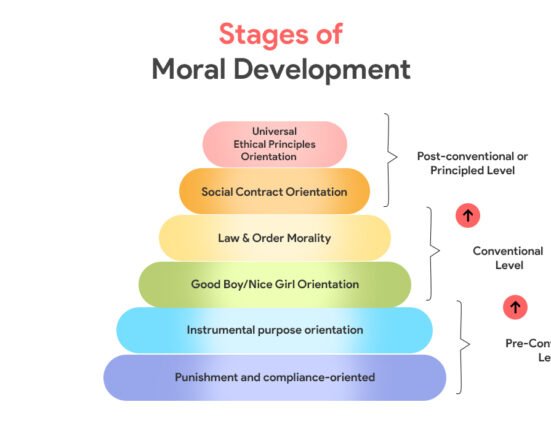
Kohlberg’s Theory of Moral Development

Exceptionality: Special Education Insights

Top 12 Psychology Books That Are A Must-Read
Along with Stanford news and stories, show me:
- Student information
- Faculty/Staff information
We want to provide announcements, events, leadership messages and resources that are relevant to you. Your selection is stored in a browser cookie which you can remove at any time using “Clear all personalization” below.

Education scholar Denise Pope has found that too much homework has negative effects on student well-being and behavioral engagement. (Image credit: L.A. Cicero)
A Stanford researcher found that too much homework can negatively affect kids, especially their lives away from school, where family, friends and activities matter.
“Our findings on the effects of homework challenge the traditional assumption that homework is inherently good,” wrote Denise Pope , a senior lecturer at the Stanford Graduate School of Education and a co-author of a study published in the Journal of Experimental Education .
The researchers used survey data to examine perceptions about homework, student well-being and behavioral engagement in a sample of 4,317 students from 10 high-performing high schools in upper-middle-class California communities. Along with the survey data, Pope and her colleagues used open-ended answers to explore the students’ views on homework.
Median household income exceeded $90,000 in these communities, and 93 percent of the students went on to college, either two-year or four-year.
Students in these schools average about 3.1 hours of homework each night.
“The findings address how current homework practices in privileged, high-performing schools sustain students’ advantage in competitive climates yet hinder learning, full engagement and well-being,” Pope wrote.
Pope and her colleagues found that too much homework can diminish its effectiveness and even be counterproductive. They cite prior research indicating that homework benefits plateau at about two hours per night, and that 90 minutes to two and a half hours is optimal for high school.
Their study found that too much homework is associated with:
* Greater stress: 56 percent of the students considered homework a primary source of stress, according to the survey data. Forty-three percent viewed tests as a primary stressor, while 33 percent put the pressure to get good grades in that category. Less than 1 percent of the students said homework was not a stressor.
* Reductions in health: In their open-ended answers, many students said their homework load led to sleep deprivation and other health problems. The researchers asked students whether they experienced health issues such as headaches, exhaustion, sleep deprivation, weight loss and stomach problems.
* Less time for friends, family and extracurricular pursuits: Both the survey data and student responses indicate that spending too much time on homework meant that students were “not meeting their developmental needs or cultivating other critical life skills,” according to the researchers. Students were more likely to drop activities, not see friends or family, and not pursue hobbies they enjoy.
A balancing act
The results offer empirical evidence that many students struggle to find balance between homework, extracurricular activities and social time, the researchers said. Many students felt forced or obligated to choose homework over developing other talents or skills.
Also, there was no relationship between the time spent on homework and how much the student enjoyed it. The research quoted students as saying they often do homework they see as “pointless” or “mindless” in order to keep their grades up.
“This kind of busy work, by its very nature, discourages learning and instead promotes doing homework simply to get points,” Pope said.
She said the research calls into question the value of assigning large amounts of homework in high-performing schools. Homework should not be simply assigned as a routine practice, she said.
“Rather, any homework assigned should have a purpose and benefit, and it should be designed to cultivate learning and development,” wrote Pope.
High-performing paradox
In places where students attend high-performing schools, too much homework can reduce their time to foster skills in the area of personal responsibility, the researchers concluded. “Young people are spending more time alone,” they wrote, “which means less time for family and fewer opportunities to engage in their communities.”
Student perspectives
The researchers say that while their open-ended or “self-reporting” methodology to gauge student concerns about homework may have limitations – some might regard it as an opportunity for “typical adolescent complaining” – it was important to learn firsthand what the students believe.
The paper was co-authored by Mollie Galloway from Lewis and Clark College and Jerusha Conner from Villanova University.
Media Contacts
Denise Pope, Stanford Graduate School of Education: (650) 725-7412, [email protected] Clifton B. Parker, Stanford News Service: (650) 725-0224, [email protected]
A Blog About Parenting: Coping Skills, Behavior Management and Special Needs
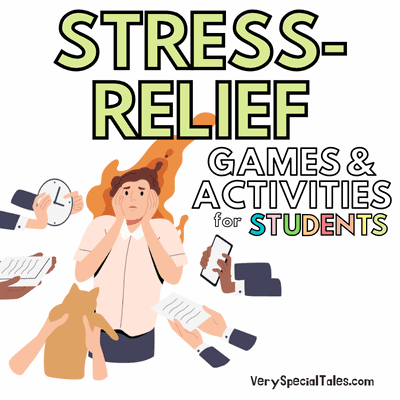
50 Best Stress-Relief Games and Activities for Students

Stress relief games and activities for students: Find effective ways to help your kids or students lower stress and deal with their big worries in healthy ways.
Stress arises when we face challenges or pressures that may seem beyond our ability to handle. It’s a reaction to feeling overwhelmed, a negative emotion that signals our body’s need to prepare for action or change.
Anxiety and stress share similarities as they both involve emotional responses to challenges or perceived threats. Stress tends to be a short-term response to a specific trigger, for example, exams or bullying. Anxiety, however, can linger even in the absence of the initial trigger.
This post explores practical stress management activities for students. We’ll cover strategies suitable for the classroom and others that may be more effectively practiced at home.
Stress and anxiety aren’t just challenges for adults; they’re very much part of kids’ lives, too.
A Gallup survey conducted from March 13 to 30, 2023, involving 2,430 U.S. college students in four-year programs, revealed that 66% reported feeling stressed, and 51% experienced worry during much of the preceding day.
A survey organized by the American College Health Association (ACHA ) identified key factors impacting students’ academic performance, including:
- Anxiety affecting 30.4% of the students
- Stress impacting 37.3% of the students.
Why Are Students Stressed Out?
Students might face stressful situations as a normal part of their day-to-day experiences, for example:
- Heavy workload : Assignments, projects, and studying can pile up.
- Exams : The pressure to perform well on tests can be overwhelming, so exams are often perceived as stressful events.
- Time management : Balancing school, activities, and personal life is challenging.
- Future concerns : Worrying about college admissions or career paths.
- Social pressures : Navigating friendships, social media, bullying, or peer competition.
- Personal issues : Dealing with personal or family health, relationships, or financial problems.
- Lack of sleep : Sacrificing sleep for study or activities leads to exhaustion.
- Limited relaxation : Not having enough time to relax or pursue hobbies.
- Learning difficulties : Struggling with course material or learning disabilities.
Signs of Stress in Students
Teachers may observe signs of stress in their students through behaviors and changes that manifest in the classroom environment:
- Lack of participation in students who used to be active
- Drop in grades or the quality of homework and classwork.
- Fidgeting, sweating, or signs of nervousness during presentations or tests.
- Withdrawal from classmates during group activities or social times like lunch.
- Reacting more emotionally or aggressively to feedback, criticism, or normal interactions.
- Headaches or stomachaches that lead to frequent visits to the school nurse.
- Signs of tiredness or lack of energy, possibly due to poor sleep.
- Struggle with focus and attention in class
- Difficulty completing tasks.
- Significant changes in behavior, such as starting conflicts or acting out.
- An increase in absences or lateness can be a sign of avoiding school due to stress
Benefits of Implementing Stress Relief Strategies in the Classroom
Students may benefit from stress relief games and activities. Potential advantages include:
- Reduce stress, helping students feel calmer and lower anxiety.
- Increase focus, leading to better learning and concentration.
- Break the monotony , making school more enjoyable.
- Build resilience by teaching different ways to handle stress.
- Promote mental health and well-being.
Stress-Relief Games and Activities for Students
Teach your kids or students some basic stress relief techniques. This section outlines essential skills and techniques complemented by a variety of stress-relief games and activities.
Deep Breathing / Breathing Exercises
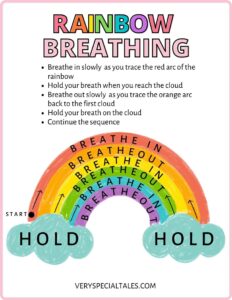
Deep breathing skills would be a great addition to the school curriculum.
Deep breathing is one of the most effective yet easy-to-implement calming tools. Taking deep breaths lets your student manage stress discreetly without drawing attention or feeling embarrassed.
Turn it into a game by teaching them fun breathing techniques like the lion breathing or the bumble bee breathing. Other fun breathing techniques include using shapes (squares, triangles, stars, etc.) that the child will trace with their finger while practicing deep breathing.
Related: 14 Fun Breathing Exercises for Kids for Home or the Classroom
Tensing and Relaxing Muscles
Tensing and relaxing muscles is an effective stress relief technique. This method reduces stress by creating muscle tension and then releasing it, helping to ease the body’s stress symptoms.
Prepare DIY Stress Balls
Preparing stress balls can be a fun classroom activity. You can teach your students that squeezing and releasing a stress ball in their hand helps relieve tension (with an added benefit, as it also strengthens the muscles!)
The class can then create their own DIY stress balls (this DIY stress balls tutorial shows two simple ways to create them in less than three minutes).
Fidgeting may help some students focus and self-regulate.
Some research has shown that kids with attention deficit hyperactivity disorder (ADHD) may find fidgeting beneficial, as physical movement may help concentration and focus.
If you wish to explore this topic further, I have a detailed post on using fidget toys in the classroom .
Mindfulness in The Classroom
“Mindfulness is the awareness that arises from paying attention, on purpose, in the present moment and non-judgmentally ” Kabat-Zinn.
Mindfulness practice can be a useful tool for helping kids of all ages regulate their emotions and control their impulses and worries.
Simple mindfulness games and activities can help you introduce and develop these skills in your children while they play and have fun.
In this article, we explore 20 great mindfulness activities for kids .
Physical Exercise
Regular physical activity can reduce symptoms of stress and anxiety.
Regular exercise promotes relaxation and enhances mood, offering immediate stress relief even in small amounts.
Teach Problem-Solving Skills
Teaching problem-solving skills can act as a stress reliever by equipping children with the ability to tackle challenges methodically and with confidence.
Explore with your students the key components of problem-solving:
- Identifying the problem
- Analyzing the problem
- Generating solutions
- Evaluating all possible solutions (Pros and Cons Analysis)
- Selecting the best solution based on our analysis and judgment.
- Implementing the best solution
- Monitoring progress and results
- Reflecting on the outcomes
Teach Planning and Organizational Skills
Teaching planning and organizational skills helps students manage their workload more effectively, reducing the feeling of being overwhelmed, which can lead to stress. These skills enable students to break tasks into manageable steps, prioritize their work, and meet deadlines more efficiently, fostering a sense of competence and reducing anxiety. Related reading: 30+ Time Management Tips & Activities for Kids
Coloring Activities

Research suggests that coloring or drawing activities may help reduce anxiety and decrease heart rate.
So, let your students grab a coloring book and see the negative feelings disappear while they engage in a creative activity.
Related reading:
- 18 Anxiety drawing ideas for kids (and adults!)
- Anxiety coloring pages for kids
Anxiety Affirmations
Anxiety affirmations are self-statements that we can use in situations that we perceive as a threat.
Those stressful situations may trigger negative thoughts that we can question with statements that
- challenge unhelpful thoughts
- focus on our strengths
- highlight personal values
- remind us of calming strategies to help us cope with physical symptoms
- contribute to a positive growth mindset
Two engaging activities that leverage the power of affirmations can bring creativity and positivity into the classroom:
- Creating Written Affirmations : This activity involves students writing their own positive affirmations. It’s a reflective exercise that encourages them to think about their strengths and aspirations, helping them build a positive mindset.
- Designing Affirmation Cards : Students can take a more artistic approach to creating affirmation cards. This involves both writing affirmations and decorating cards to reflect the positive message. It’s a creative way to engage with affirmations and adds a personal touch to their positive thoughts.
- Positive Affirmation Exchanges: Kids share uplifting messages with each other to build confidence and positivity.
For inspiration:
- 80 Positive Affirmations for Anxiety (Blog post)
- Anxiety Affirmation Cards (Printable product)
Stress Classroom Workshop
Consider hosting a classroom workshop where students can:
- Learn about stress (triggers, symptoms in their mind and bodies)
- Explore stress-relief strategies
- Practice strategies with games and activities (like e role-playing scenarios, group discussions to share experiences and tips, or mindfulness exercises)
Anxiety Books and Workbooks
We have developed some great resources to help kids and teens navigate their worries and feelings of stress and anxiety. These workbooks cover a wide range of anxiety-related topics: biology, triggers, strategies, worry thoughts and the role of imagination, how worry may affect everyday life, the trap of avoidance behaviors, etc.
You may check them below:
- No Worries Journal for KIDS
- No Worries Journal for TEENS
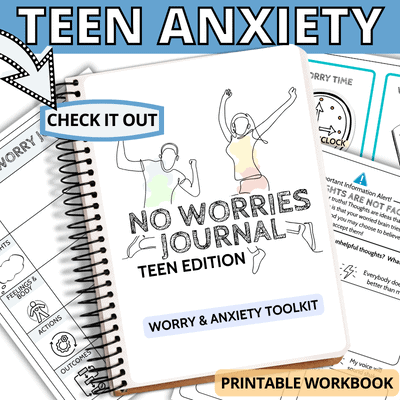
I’ve also curated a list of great books for kids of all ages. You may check them out in the article below:
- Best Books About Anxiety for Kids and Teens
But, whether or not a book directly addresses anxiety, simply reading can be a powerful tool to help kids distract from stress and worry.
Calming Box / Calm-Down Corner
Create a “ calm-down corner ” or designated calming space where children can go to manage their big emotions when feeling overwhelmed, upset, or stressed out.
If space is an issue, a calming box may be your next best option. A calm-down toolbox allows your students to access all the items that facilitate their calm-down strategies easily.
Check out our Calming Box/Calm Down Corner Easy Guide for tips and advice on implementing either of those two helpful tools.
Brain Break Activities
Brain breaks are physical or mental exercises between periods of educational work designed to provide mental rest and help the brain refocus and recharge.
Taking a short break during class may also help reduce stress, allowing students a chance to relax and refresh their minds.
Many of the activities and games mentioned here can work as brain breaks. But if you wish to check out many more ideas, I recommend the following article:
- 60 Brain Break Activities for Kids
Other Fun Stress-Relief Activities
These are some examples of fun activities to help relieve stress in the classroom.
- Silent reading time
- Group meditation or guided imagery
- Short stretching or yoga session
- Silent writing prompts
- Walks around the school
- Origami or simple craft-making
- Gratitude circle (sharing things they’re grateful for)
- Storytelling circle (sharing stories or experiences)
- Indoor scavenger hunts
- Quick classroom cleanup races
- Doodle time
- Classroom circle where everyone shares a positive thought
- Music time (listening and discussing)
- Peer teaching sessions on hobbies, interests, or school topics
- Classroom picnic (indoor or outdoor) / Shared lunch
- Guided journaling or diary entries
Best Stress-Relief Games
Games, even those not specifically designed to target stress, can serve as effective stress relievers for kids by providing a fun escape from worries or challenges and promoting social interaction and laughter. Some fun ideas that are easy to implement in the classroom:
- Classroom karaoke
- Pictionary or drawing games
- Quick dance-off to a fun song
- Indoor scavenger hunt
- Bubble wrap popping (noisy but so pleasant! This one may be a good idea for home)
- Puzzle games
- Puzzle-solving as a group
- Jigsaw puzzle
- Simon Says with stress relief movements
- Educational board games
- Classroom comedy hour (sharing jokes)
- “Classroom Olympics” with simple, fun competitions
After-School Soothing Activities
After a busy day at school, incorporating stress relief activities into the daily routine can help reduce stress levels.
Here are a few things kids can try to help them unwind:
- Outdoor Activities : Spending time outdoors, whether playing sports or simply running around, can help reduce stress and improve mood.
- Creative Arts : Activities like drawing, painting, or crafting allow for creative expression and can be very soothing.
- Reading for Pleasure : Getting lost in a good book can be a great escape and a way to unwind.
- Listening to Music or Podcasts : Calming music or engaging podcasts can help children relax and find enjoyment.
- Play phone or computer games like Candy Crush, Minecraft, or their favorite game!
- Rest and Nutrition : Ensuring they get enough sleep and eat balanced meals can also play a crucial role in managing stress effectively.
Other Stress and Anxiety Resources
- 101 Calming Strategies for Kids
- 43 Anxiety Activities for Kids
- Anxiety and Autism: Triggers and Calming Strategies
- School Anxiety: Useful Strategies to Reduce Anxiety in the Classroom

Leave a Reply Cancel reply
Your email address will not be published. Required fields are marked *

How to Reduce Homework Stress
If homework is a source of frustration and stress in your home, it doesn’t have to be that way! Read on to learn effective strategies to reduce your child’s homework stress.

Author Katie Wickliff
Published March 2024

If homework is a source of frustration and stress in your home, it doesn’t have to be that way! Read on to learn effective strategies to reduce your child’s homework stress.
- Key takeaways
- Homework stress can be a significant problem for children and their families
- An appropriate amount of quality homework can be beneficial for students
- Parents can help reduce homework stress in several key ways
Table of contents
- Homework stress effects
- How to reduce homework stress
As a parent who has felt the frustration of watching my child be reduced to tears because of her homework each night, I’ve often wondered: do these math worksheets and reading trackers really make a difference to a child’s academic success? Or does homework cause stress without having a positive impact on learning?
If your child experiences a significant amount of homework stress, you may feel at a loss to help. However, there are several things you can do at home to minimize the negative effects of this stress on your child–and you! We’ve put together a list of research-based practices that can help your child better handle their homework load.
The Effects of Homework Stress on Students
Does homework cause stress? Short answer: Yes. It’s been well documented that too much homework can cause stress and anxiety for students–and their parents. However, do the benefits of homework outweigh the costs? Is homework “worth” the frustration and exhaustion that our children experience?
Findings on the benefits of homework at the elementary school level are mixed, with studies showing that homework appears to have more positive effects under certain conditions for certain groups of students.
After examining decades of studies on the relationship between homework and academic achievement, leading homework researcher Harris M. Cooper has proposed the “10-minute rule,” suggesting that homework be limited to 10 minutes per grade level. For example, children in 3rd grade should do no more than 30 minutes of homework daily, while a 1st grader should do no more than 10 minutes of homework. The National Parent Teacher Association and the National Education Association both endorse this guideline as a general rule of thumb.
Because of these research findings, Doodle believes that an appropriate amount of quality homework can help students feel more positive about learning and can provide parents with a critical connection to their child’s school experience . But to keep learning positive, we need to reduce the amount of stress both students and parents feel about homework.
1. Routine, Routine, Routine
Creating an after-school routine and sticking to it helps children feel organized, but with sports, tutoring, or music lessons, many children have varying weekday schedules. As a former classroom teacher and private tutor, I suggest that families post a weekly schedule somewhere visible and communicate that schedule with their child.
At our house, we have a dry-erase calendar posted on the wall. Every Sunday evening, I write both of my children’s schedules for the following week–including homework time. We go through the calendar together, and they reference it often throughout the week. I can tell both my son and daughter feel better when they know when they’ll get their homework done.
2. Create a Homework Space
Ideally, your child should have a dedicated homework space. It doesn’t matter if that space is a desk, a dining room table, or a kitchen countertop. What does matter is that the homework area is tidy, because an unorganized homework area is very distracting.
3. Start Homework Early
Encourage your child to start their homework as early as possible. Help them review their assignments, make a plan for what needs to be completed, and then dive in. Naturally, children are more tired later in the evening which can lead to more stress.
4. Encourage Breaks
If you can see your child becoming frustrated or overwhelmed by their homework, encourage them to take a breather and come back to it later. As a teacher and tutor, I called this a “brain break” and believe these breaks are essential. Taking a short break will give your child a chance to step away from a frustrating problem or assignment.
5. It’s Okay to Ask for Help
Sometimes, homework can become just too stressful and overwhelming. In that case, it really is okay to stop. Children can learn to advocate for themselves by making a list of questions for their teacher and asking for help the next day. Depending on their age, you might need to help role-play how to approach their teacher with their frustrations.
Additionally, parents should never feel afraid to contact their child’s teacher to talk about homework issues. When I was teaching elementary school, I always wanted parents to feel comfortable reaching out about any issues, including homework stress.
6. Get Plenty of Rest
Sleep is critical to a child’s overall wellbeing , which includes their academic performance. Tired kids can’t concentrate as well, which can lead to feeling more overwhelmed about homework assignments. According to the American Academy of Sleep Medicine, kids aged 6-12 should get at least 9 hours of sleep each night.

7. Consider a Homework Group
Organizing a homework group a few times a week is another way for your child to view homework more positively. Working as a group encourages collaboration, while discussions can solidify concepts learned in class.
8. Encourage Positivity
No matter what your school experience was like, it’s important to model a growth mindset for your child. A growth mindset is the belief that your abilities can develop and improve over time. So if your child says something like “ I can’t do this! ” first acknowledge their frustration. Then, encourage them to say, “ I may not understand this yet, but I will figure it out. ” Speaking positively about tough experiences takes practice, but it will go a long way in reducing homework stress for your child.
9. Develop Skills With Fun Games
Feeling stressed about homework is no fun. Completing worksheets and memorizing facts is necessary, but playing games is a great way to inject some excitement into learning. Doodle’s interactive math app is filled with interactive exercises, engaging math games, and unique rewards that help kids develop their skills while having fun.
Lower Math Anxiety with DoodleMath
Does your child struggle with math anxiety? DoodleMath is an award-winning math app f illed with fun, interactive math questions aligned to state standards. Doodle creates a unique work program tailored to each child’s skill level to boost confidence and reduce math anxiety. Try it free today!

FAQs About Homework Stress
Many studies have shown that homework and stress often go hand-in-hand, often because many children feel pressure to perform perfectly or they have trouble managing their emotions–they get overwhelmed or flooded easily.
You can help your child reduce homework stress in several ways, including by establishing a routine, creating a homework space, encouraging breaks, and making homework fun with online games or math apps.

Lesson credits

Katie Wickliff
Katie holds a master’s degree in Education from the University of Colorado and a bachelor’s degree in both Journalism and English from The University of Iowa. She has over 15 years of education experience as a K-12 classroom teacher and Orton-Gillingham certified tutor. Most importantly, Katie is the mother of two elementary students, ages 8 and 11. She is passionate about math education and firmly believes that the right tools and support will help every student reach their full potential.

Parents, sign up for a DoodleMath subscription and see your child become a math wizard!

What we offer
Quick links
All rights reserved.

Are you a parent, teacher or student?
Get started for free!
Maths information pack
We ask for your contact info so we can send our info pack directly to your inbox for your convenience, exam prep information pack, case studies information pack.
Book a chat with our team

I’m new to Doodle

My school is already using Doodle

Information pack
We ask for your contact info so that our education consultants can get in touch with you and let you know a bit more about doodle., student login, which programme would you like to use.
DoodleMaths
DoodleTables
DoodleEnglish
DoodleSpell
If you’d like to use Doodle’s browser version, please visit this page on a desktop.
To log in to Doodle on this device, you can do so through our apps. You can find out how to download them here:
How to Deal With Stress During Exam and Assignment Time

Whether you’ve got five assignments due on the same day or what seems like infinite back-to-back exams, every student feels the pressure at some point.
And if you don’t, you must be superhuman and can disregard this article.
Now, just to clear things up, I’m not about to give you a bunch of tips on how to study or how to get the best grade, because frankly, it would probably be poor advice.
However, I feel that I can share some ideas on how to keep cool while pushing through these stressful periods. It’s easy to lose sight of anything outside of the educational world when the clock is ticking and the deadline’s approaching. Hopefully, just being aware of these games the mind can play may help you cope. Hopefully.
1. Remember what you’re fighting for.
I’ve always found that knowing what I’m working towards helps me cope while counting down the days. It’s important to have a reward in mind that can be enjoyed after pushing through the hard times. For some people, it could be finally being able to catch up on that movie everyone is talking about. For others, it’s an overseas trip. Some may even take comfort in the simple fact that in two weeks, when all exams have been sat, they can sit on the couch and do absolutely nothing for a month. Whatever it is, keep it in mind, especially when the pressure reaches its maximum.
2. Take a breath.
Let what you’ve just studied sink in, or let your ideas percolate. Taking breaks allows your mind to rest and to not be in a constant state of action. Breaks don’t need to even be long. Just a few minutes of separating yourself from your studies can make all the difference.
3. Recharge the ol’ batteries.
Sacrificing sleep for study is incredibly tempting sometimes. Perhaps it feels like that extra hour of revision will make all the difference. However, sleep is essential! Really, what good is cramming so much information into your brain if you’re not alert enough to use it?
4. Know the task at hand.
Creating a checklist is a great way to stay motivated. For starters, breaking down large study loads or assignments into smaller tasks can help to make them feel more manageable. Not only that, but the satisfaction gained from checking off each task is unparalleled.
5. Make like a gymnast and be flexible.
As helpful as checklists or schedules can be, they also have the potential to be a hindrance. In my experience, rigidity is directly proportional to stress levels. Don’t be afraid to alter a plan as you go. The fact is, if you force yourself to stick to a plan that simply isn’t doable, your anxiety is sure to skyrocket. It is certainly a good idea to have a plan, as long as it remains adaptable.
6. You are not alone.
The most powerful tool anyone has when dealing with these stressful situations is the support of family and friends. Let people around you know when exams are coming up or that your next big assignment deadline is not far away. Tell them to expect you to be more on edge than usual. And when the stress really hits, lean on your support network. Just telling one person how you’re feeling can sometimes be all you need. Sometimes not, but that’s where the previously-mentioned tips come into play…
If you or anyone you know needs help, support is available now. Call Lifeline on 131 114 or Kids Helpline on 1800 551 800.
Visit ReachOut to get support to help you with everything from everyday issues through to tough times.
Ref: 938017be-e979-4750-af9c-a8fc004e8316
You may also like

Achieve Ultimate Zen With Our Students' Original Exam Haikus

End-of-Year Exams Have Arrived: Are You Even Ready?

How to Handle Exam Anxiety: Six Steps to Help You Identify and Overcome Study Stresses
Most popular.

All the Jobs You Didn’t Know Existed in the Australian Federal Police

HOYTS - $12.50 HOYTS GA ticket (Mon-Thurs)

Spin to Win 1 of 3 $150 VISA gift cards
Comments & feedback.
Share your opinion
Emoji cheat sheet Formatting Comment guide line s
Think about how happy you’ll be when u get great grades :)
Hey there! Join the Student Edge fam to:
- Gain access to exclusive deals
- Win epic prizes & paid surveys
- Get helpful study tips and tricks
4 Simple Ways to Ease Your Students’ Stress
Explore more.
- Course Design
- Perspectives
- Student Support
O ver the past decade, the prevalence of mental health problems among college students has risen steadily. In our national Healthy Minds Study , which surveys over 800,000 students, we have seen these challenges go from bad to worse. Collected annually at hundreds of US colleges and universities, the data reveals a significant increase in symptoms of depression (22 percent in 2012 to 44 percent in 2022), anxiety (17 percent to 38 percent), and suicidality (8 percent to 15 percent).
In a multi-campus survey of faculty in the US , nearly 80 percent reported having had a one-on-one conversation with a student about the student’s mental health in the past year. Roughly two-thirds of faculty indicated that they are motivated to strengthen their role in supporting student mental health, a clear indication that most faculty are open to helping address what many refer to as a college student mental health crisis.
As faculty, most of us are not trained mental-health professionals—and that’s OK. We can still make changes, even in small ways, that will do a lot to ease our students’ stress and anxieties . So as you plan out your next classes, consider ways you can support your students by asking yourself the following four questions.
1. Are my deadlines set at healthy times?
When choosing a deadline for assignments, think about whether that time is healthy for your students. For instance, if you’re telling students that papers or projects are due at midnight, know that they’re likely skipping dinner, they’re working late, and they’ll be sending you an email at 11:59 p.m. A deadline of nine a.m. is similar; your students will pull an all-nighter to get your assignment done.
Many educators may not think about what these deadlines mean for their students. That’s why I always set five p.m. deadlines, and I let my students know why this time was an intentional decision. I say, “I want you to have dinner. I want you to sleep. And I don’t want this class to interfere with your well-being.”
2. How can I lower the stakes yet maintain academic rigor?
As part of our research , students often share how much pressure they feel around exams, huge projects, and other forms of evaluations. The stakes feel really high for them. Consider whether there are opportunities to lower the stakes while maintaining academic rigor and learning outcomes.
I’m not suggesting that we eliminate all pressure, but can we turn down the dial ?
One way I do this is by having my doctoral students submit their research proposals in two rounds. First, they hand over a draft, which I review and grade, giving detailed feedback. I let them know that I don’t expect their drafts to be perfect. I then make referrals to our writing and library resources and offer to meet one on one with students. Later, when they pass in the final research proposal, they also include a statement, letting me know what they decided to change from the first draft and how they incorporated feedback. With this staggered approach, I’m explicitly showing my students that I care more about their improvement and growth than I do about the grades .
Of course, how you approach lowering the stakes in your class will depend on the discipline, course type, and other factors. But the idea is to create a culture of curiosity rather than fear.
3. Do my students feel like they belong?
Loneliness is an epidemic , according to the US surgeon general, and we’re not the only country grappling with this issue. For our students’ well-being (which is an integral factor in their learning), it’s important that we as educators help them feel part of a community.
One way I do this in my three-hour class of roughly 20 doctoral students is by setting aside 10 to 15 minutes at the beginning of every class for students to connect with each other. I call this time “Community.” I usually pose a question for discussion, something about navigating graduate school or work-life balance. The only rule is that students must be loud. I want my classroom noisy . Not only does this set the tone and energy for the rest of the class session, but it also helps students feel connected to their peers.
4. Have I humanized myself and shared my failures?
Our students often doubt their abilities and suffer from impostor syndrome —the feeling that they’re faking competency. Part of it is that they look at us, the faculty, and think we’re these perfect examples of success.
So I borrowed an idea that was started at Harvard and replicated it at Boston University. The initiative is called “Reflections on Rejections,” a written compilation of faculty members and others sharing their experiences with rejection, failure, and setbacks in academia. It’s powerful for students to learn that faculty have faced many more rejections than successes throughout our careers.
That’s just one way to normalize some of the challenges in academia and really humanize faculty to students. There are several ways educators can do this on a smaller scale.
Sending a Clear Message That Student Well-Being Matters
The smallest changes can have the biggest impact on our students’ stress levels. So reexamine the default parameters you’ve set and try to find opportunities in your curriculum and daily classroom routines to lighten the burden while maintaining learning outcomes.
If you’re unsure where to look beyond the suggestions above, ask your students. Remind them that you’re here to support their well-being.

Sarah Ketchen Lipson is an associate professor in the Department of Health Law Policy and Management at the Boston University School of Public Health. She is principal investigator of the Healthy Minds Network , which includes the Healthy Minds Study , the largest, most comprehensive study of mental health in higher education.
Related Articles

We use cookies to understand how you use our site and to improve your experience, including personalizing content. Learn More . By continuing to use our site, you accept our use of cookies and revised Privacy Policy .

The Tiger's Tale
Homework should not be given on the weekend.
Homework’s effectiveness is in question, and stress is a real problem. Therefore, homework should not be given on the weekend.
Jessie Cao , Photo Editor | December 1, 2016
Imagine coming out of school and expecting to make plans for the weekend once you get home. When you walk through your front door, you are distraught and remember about your homework that is due on Monday. Due to the amount of homework, you are homebound and the days where you were supposed to be relaxed are ruined.
Weekends are supposed to be the days that students, and everyone else, get to recharge. Homework defeats the purposes of weekends. When students are assigned homework over the weekends, this makes them feel like they have no break. Students become stressed out on the days they are supposed to relax when they have to worry about homework.
To prevent this from happening, students should not receive assignments on the weekends. This can happen by teachers planning their lessons out each week, so the content does not spill into the weekend. While that may mean more time for homework on each weekday, students will enter the weekend with less to worry about.
According to Open College’s Website, The U.S. National Education Association recommends no more than ten minutes per grade level, per night. Sometimes, homework has even been legislated. In, fact California banned homework for students under the age of 15 in 1901! Even older students were limited to 20 recitations a week.
Homework does not improve student knowledge, according to Open Colleges. Duke University found 60 studies that assigning homework was good, but too much homework was not. Harris Cooper is a leading homework research that suggests homework needs to be “uncomplicated and short, involve families, and engage student interests.”
Stanford News even reported that homework creates stress. In fact 56% of student stress is caused by homework. 33% is caused by the worry of receiving good grades on homework. Less than one percent of students say that homework doesn’t stress them. Studies show that this affects families as well. This puts stress on families because of the ability to not help the child with the homework.
“The data shows that homework over this level is not only not beneficial to children’s grades or GPA, but there’s really a plethora of evidence that it’s detrimental to their attitude about school, their grades, their self-confidence, their social skills, and their quality of life,” said Stephanie Donaldson-Pressman to CNN. She is an expert in family health dynamics.
Although homework does not necessarily benefit students, teachers may think otherwise. For their perspective, homework can enhance the lesson taught to make sure the students remember the content. Homework on the weekends, in a teacher’s perspective, is seen as improving students knowledge. Even if that were true, the stress homework inflicts still has a negative impact. Therefore, let the weekends be homework-free.
Moving forward, it would be best for students to not have homework on the weekends. The weekends should be the weekends, not a continuation of the week.
Van plows through the fence and drives across the back field
On Tuesday February 21 at around 4:40, a car ran through the fence in the back field behind the basketball courts. The suspect's name was Nicholas San...
After losing in the knock-out rounds, MacArthur’s boys basketball finishes third
The MacArthur Boys Basketball team placed third in the intermediate school tournament that took place at Segerstrom High School. The March 25 compet...
Atmospheric river affects MacArthur with heavy rain
Over the past few weeks, rounds of Atmospheric Rivers have hit the Southern California region, affecting the MacArthur students and staff. Multiple lo...
Students no longer benefit from 50% grading floor
In the 2022-23 school year, all Macarthur students will no longer have the 50% floor in Aeries and will have to work harder to keep their grades up. T...
Second Awards Assembly celebrates accomplishments from Semester 1
On Friday, January 27, all MacArthur students attended the 2nd awards assembly in the quad after the second period. In Tiger Connection, the awards we...
The Winter Dance raised funds for the Explorer’s Club, C.J.S.F.
Seventh-grade honors students participate in National History Day competition
Eighth graders take the annual Constitution Test
8th graders “passed laws” and “elected a president” as part of annual Model Congress
Expectations Assembly brings the dress code to the forefront
The student news site of MacArthur Fundamental Intermediate School
- Open access
- Published: 24 February 2024
Physical activity improves stress load, recovery, and academic performance-related parameters among university students: a longitudinal study on daily level
- Monika Teuber 1 ,
- Daniel Leyhr 1 , 2 &
- Gorden Sudeck 1 , 3
BMC Public Health volume 24 , Article number: 598 ( 2024 ) Cite this article
3857 Accesses
30 Altmetric
Metrics details
Physical activity has been proven to be beneficial for physical and psychological health as well as for academic achievement. However, especially university students are insufficiently physically active because of difficulties in time management regarding study, work, and social demands. As they are at a crucial life stage, it is of interest how physical activity affects university students' stress load and recovery as well as their academic performance.
Student´s behavior during home studying in times of COVID-19 was examined longitudinally on a daily basis during a ten-day study period ( N = 57, aged M = 23.5 years, SD = 2.8, studying between the 1st to 13th semester ( M = 5.8, SD = 4.1)). Two-level regression models were conducted to predict daily variations in stress load, recovery and perceived academic performance depending on leisure-time physical activity and short physical activity breaks during studying periods. Parameters of the individual home studying behavior were also taken into account as covariates.
While physical activity breaks only positively affect stress load (functional stress b = 0.032, p < 0.01) and perceived academic performance (b = 0.121, p < 0.001), leisure-time physical activity affects parameters of stress load (functional stress: b = 0.003, p < 0.001, dysfunctional stress: b = -0.002, p < 0.01), recovery experience (b = -0.003, p < 0.001) and perceived academic performance (b = 0.012, p < 0.001). Home study behavior regarding the number of breaks and longest stretch of time also shows associations with recovery experience and perceived academic performance.
Conclusions
Study results confirm the importance of different physical activities for university students` stress load, recovery experience and perceived academic performance in home studying periods. Universities should promote physical activity to keep their students healthy and capable of performing well in academic study: On the one hand, they can offer opportunities to be physically active in leisure time. On the other hand, they can support physical activity breaks during the learning process and in the immediate location of study.
Peer Review reports
Introduction
Physical activity (PA) takes a particularly key position in health promotion and prevention. It reduces risks for several diseases, overweight, and all-cause mortality [ 1 ] and is beneficial for physical, psychological and social health [ 2 , 3 , 4 , 5 ] as well as for academic achievement [ 6 , 7 ]. However, PA levels decrease from childhood through adolescence and into adulthood [ 8 , 9 , 10 ]. Especially university students are insufficiently physically active according to health-oriented PA guidelines [ 11 ] because of academic workloads as well as difficulties in time management regarding study, work, and social demands [ 12 ]. Due to their independence and increasing self-responsibility, university students are at a crucial life stage. In this essential and still educational stage of the students´ development, it is important to study their PA behavior. Furthermore, PA as health behavior represents one influencing factor which is considered in the analytical framework of the impact of health and health behaviors on educational outcomes which was developed by the authors Suhrcke and de Paz Nieves [ 13 , 14 ]. In light of this, the present study examines how PA affects university students' academic situations.
Along with the promotion of PA, the reduction of sedentary behavior has also become a crucial part of modern health promotion and prevention strategies. Spending too much time sitting increases many health risks, including the risk of obesity [ 15 ], diabetes [ 16 ] and other chronic diseases [ 15 ], damage to muscular balances, bone metabolism and musculoskeletal system [ 17 ] and even early death [ 15 ]. University students are a population that has shown the greatest increase in sedentary behavior over the last two decades [ 18 ]. In Germany, they show the highest percentage of sitting time among all working professional groups [ 19 ]. Long times sitting in classes, self-study learning, and through smartphone use, all of which are connected to the university setting and its associated behaviors, might be the cause of this [ 20 , 21 ]. This goes along with technological advances which allow students to study in the comfort of their own homes without changing locations [ 22 ].
To counter a sedentary lifestyle, PA is crucial. In addition to its physical health advantages, PA is essential for coping with the intellectual and stress-related demands of academic life. PA shows positive associations with stress load and academic performance. It is positively associated with learning and educational success [ 6 ] and even shows stress-regulatory potential [ 23 ]. In contrast, sedentary behavior is associated with lower cognitive performance [ 24 ]. Moreover, theoretical derivations show that too much sitting could have a negative impact on brain health and diminish the positive effects of PA [ 16 ]. Given the theoretical background of the stressor detachment model [ 25 ] and the cybernetic approach to stress management in the workplace [ 26 ], PA can promote recovery experience, it can enhance academic performance, and it is a way to reduce the impact of study-related stressors on strain. Load-related stress response can be bilateral: On the one hand, it can be functional if it is beneficial to help cope with the study demands. On the other hand, it can be dysfunctional if it puts a strain on personal resources and can lead to load-related states of strain [ 27 ]. Thus, both, the promotion of PA and reduction of sedentary behavior are important for stress load, recovery, and performance in student life, which can be of particular importance for students in an academic context.
A simple but (presumably) effective way to integrate PA and reduce sedentary behavior in student life are short PA breaks. Due to the exercises' simplicity and short duration, students can perform them wherever they are — together in a lecture or alone at home. Short PA breaks could prevent an accumulation of negative stressors during the day and can help with prolonged sitting as well as inactivity. Especially in the university setting, evidence of the positive effects of PA breaks exists for self-perceived physical and psychological well-being of the university students [ 28 ]. PA breaks buffer university students’ perceived stress [ 29 ] and show positive impacts on recovery need [ 30 ] and better mood ratings [ 31 , 32 ]. In addition, there is evidence for reduction in tension [ 30 ], overall muscular discomfort [ 33 ], daytime sleepiness or fatigue [ 33 , 34 ] and increase in vigor [ 34 ] and experienced energy [ 30 ]. This is in line with cognitive, affective, behavioral, and biological effects of PA, all categorized as palliative-regenerative coping strategies, which addresses the consequences of stress-generating appraisal processes aiming to alleviate these consequences (palliative) or restore the baseline of the relevant reaction parameter (regenerative) [ 35 , 36 ]. This is achieved by, for example, reducing stress-induced cortisol release or tension through physical activity (reaction reduction) [ 35 ]. Such mechanisms are also in accordance with the previously mentioned stressor detachment model [ 25 ]. Lastly, there is a health-strengthening effect that impacts the entire stress-coping-health process, relying on the compensatory effects of PA which is in accordance to the stress-buffering effect of exercise [ 37 ]. Health, in turn, effects educational outcomes [ 13 , 14 ]. Therefore, stress regulating effects are also accompanied with the before mentioned analytical framework of the impact of health and health behaviors on educational outcomes [ 13 , 14 ].
Focusing on the effects of PA, this study is guided by an inquiry into how PA affects university students' stress load and recovery as well as their perceived academic performance. For that reason, the student´s behavior during home studying in times of COVID-19 is examined, a time in which reinforced prolonged sitting, inactivity, and a negative stress load response was at a high [ 38 , 39 , 40 , 41 , 42 ]. Looking separately on the relation of PA with different parameters based on the mentioned evidence, we assume that PA has a positive impact on stress load, recovery, and perceived academic performance-related parameters. Furthermore, a side effect of the home study behavior on the mentioned parameters is assumed regarding the accumulation of negative stressors during home studying. These associations are presented in Fig. 1 and summarized in the following hypotheses:
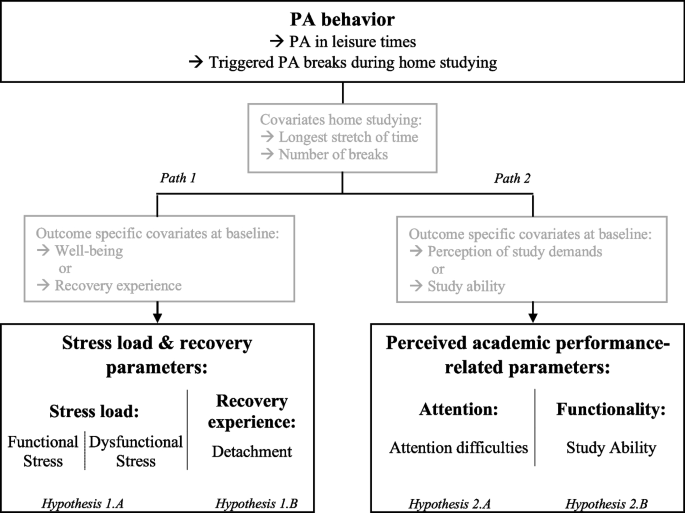
Overview of the assumed effects and investigated hypotheses of physical activity (PA) behavior on variables of stress load and recovery and perceived academic performance-related parameters
Hypothesis 1 (path 1): Given that stress load always occurs as a duality—beneficial if it is functional for coping, or exhausting if it puts a strain on personal resources [ 27 ] – we consider two variables for stress load: functional stress and dysfunctional stress. In order to reduce the length of the daily surveys, we focused the measure of recovery only on the most obvious and accessible component of recovery experience, namely psychological detachment. PA (whether performed in leisure-time or during PA breaks) encourages functional stress and reduce dysfunctional stress (1.A) and has a positive effect on recovery experience through psychological detachment (1.B).
Hypothesis 2 (path 2): The academic performance-related parameters attention difficulties and study ability are positively influenced by PA (whether done in leisure-time or during PA breaks). We have chosen to assess attention difficulties for a cognitive parameter because poor control over the stream of occurring stimuli have been associated with impairment in executive functions or academic failure [ 43 , 44 , 45 , 46 ]. Furthermore, we have assessed the study ability to refer to the self-perceived feeling of functionality regarding the demands of students. PA reduces self-reported attention difficulties (2.A) and improves perceived study ability, indicating that a student feels capable of performing well in academic study (2.B).
Hypothesis 3: We assume that a longer time spent on studying at home (so called home studying) could result in higher accumulation of stressors throughout the day which could elicit immediate stress responses, while breaks in general could reduce the influence of work-related stressors on strain and well-being [ 47 , 48 ]. Therefore, the following covariates are considered for secondary effects:
the daily longest stretch of time without a break spent on home studying
the daily number of breaks during home studying
Study setting
The study was carried out during the COVID-19 pandemic containment phase. It took place in the middle of the lecture period between 25th of November and 4th of December 2020. Student life was characterized by home studying and digital learning. A so called “digital semester” was in effect at the University of Tübingen when the study took place. Hence, courses were mainly taught online (e.g., live or via a recorded lecture). Other events and actions at the university were not permitted. As such, the university sports department closed in-person sports activities. For leisure time in general, there were contact restrictions (social distancing), the performance of sports activities in groups was not permitted, and sports facilities were closed.
Thus, the university sports department of the University of Tübingen launched various online sports courses and the student health management introduced an opportunity for a new digital form of PA breaks. This opportunity provided PA breaks via videos with guided physical exercises and health-promoting explanations for a PA break for everyday home studying: the so called “Bewegungssnack digital” [in English “exercise snack digital” (ESD)] [ 49 ]. The ESD videos took 5–7 min and were categorized into three thematic foci: activation, relaxation, and coordination. Exercises were demonstrated by one or two student exercise leaders, accompanied by textual descriptions of the relevant execution features of each exercise.
Participants
Participants were recruited within the framework of an intervention study, which was conducted to investigate whether a digital nudging intervention has a beneficial effect on taking PA breaks during home study periods [ 49 ]. Students at the University of Tübingen which counts 27,532 enrolled students were approached for participation through a variety of digital means: via an email sent to those who registered for ESD course on the homepage of the university sports department and to all students via the university email distribution list; via advertisement on social media of the university sports department (Facebook, Instagram, YouTube, homepage). Five tablets, two smart watches, and one iPad were raffled off to participants who engaged actively during the full study period in an effort to motivate them to stick with it to the end. In any case, participants knew that the study was voluntary and that they would not suffer any personal disadvantages should they opt out. There was a written informed consent prompt together with a prompt for the approval of the data protection regulations immediately within the first questionnaire (T0) presented in a mandatory selection field. Positive ethical approval for the study was given by the first author´s institution´s ethics committee of the faculty of the University of Tübingen.
Participants ( N = 57) who completed the daily surveys on at least half of the days of the study period, were included in the sample (male = 6, female = 47, diverse = 1, not stated = 3). As not all subjects provided data on all ten study days, the total number of observations was between 468 and 540, depending on the variable under study (see Table 1 ). The average number of observations per subject was around eight. Their age was between 18 and 32 years ( M = 23.52, SD = 2.81) and they were studying between the 1st to 13th semester ( M = 5.76, SD = 4.11) within the following major courses of study: mathematical-scientific majors (34.0%), social science majors (22.6%), philosophical majors (18.9%), medicine (13.2%), theology (5.7%), economics (3.8%), or law (1.9%). 20.4% of the students had on-site classroom teaching on university campus for at least one day a week despite the mandated digital semester, as there were exceptions for special forms of teaching.
Design and procedures
To examine these hypothesized associations, a longitudinal study design with daily surveys was chosen following the suggestion of the day-level study of Feuerhahn et al. (2014) and also of Sonnentag (2001) measuring recovery potential of (exercise) activities during leisure time [ 50 , 51 ]. Considering that there are also differences between people at the beginning of the study period, initial base-line value variables respective to the outcomes measured before the study period were considered as independent covariates. Therefore, the well-being at baseline serves as a control for stress load (2.A), the psychological detachment at baseline serves as a control for daily psychological detachment (2.B), the perception of study demands serves as a control for self-reported attention difficulties (1.A), and the perceived study ability at baseline serves as a control for daily study ability (2.B).
Subjects were asked to continue with their normal home study routine and additionally perform ESD at any time in their daily routine. Data were collected one to two days before (T0) as well as daily during the ten-day study period (Wednesday to Friday). The daily surveys (t 1 -t 10 ) were sent by email at 7 p.m. every evening. Each day, subjects were asked to answer questions about their home studying behavior, study related requirements, recovery experience from study tasks, attention, and PA, including ESD participation. The surveys were conducted online using the UNIPARK software and were recorded and analyzed anonymously.
Measures and covariates
In total, five outcome variables, two independent variables, and seven covariates were included in different analyses: three variables were used for stress load and recovery parameters, two variables for academic performance-related parameters, two variables for PA behavior, two variables for study behavior, four variables for outcome specific baseline values and one variable for age.
Outcome variables
Stress load & recovery parameters (hypothesis 1).
Stress load was included in the analysis with two variables: functional stress and dysfunctional stress. Followingly, a questionnaire containing a word list of adjectives for the recording of emotions and stress during work (called “Erfassung von Emotionen und Beanspruchung “ in German, also known as EEB [ 52 ]) was used. It is an instrument which were developed and validated in the context of occupational health promotion. The items are based on mental-workload research and the assessment of the stress potential of work organization [ 52 ]. Within the questionnaire, four mental and motivational stress items were combined to form a functional stress scale (energetic, willing to perform, attentive, focused) (α = 0.89) and four negative emotional and physical stress items were combined to form dysfunctional stress scale (nervous, physically tensioned, excited, physically unwell) (α = 0.71). Participants rated the items according to how they felt about home studying in general on the following scale (adjustment from “work” to “home studying”): hardly, somewhat, to some extent, fairly, strongly, very strongly, exceptionally.
Recovery experience was measured via psychological detachment. Therefore, the dimension “detachment” of the Recovery Experience Questionnaire (RECQ [ 53 ]) was adjusted to home studying. The introductory question was "How did you experience your free time (including short breaks between learning) during home studying today?". Students responded to four statements based on the extent to which they agreed or disagreed (not at all true, somewhat true, moderately true, mostly true, completely true). The statements covered subjects such as forgetting about studying, not thinking about studying, detachment from studying, and keeping a distance from student tasks. The four items were combined into a score for psychological detachment (α = 0.94).
Academic performance-related parameters (hypothesis 2)
Attention was assessed via the subscale “difficulty maintaining focused attention performance” of the “Attention and Performance Self-Assessment” (ASPA, AP-F2 [ 54 ]). It contains nine items with statements about disturbing situations regarding concentration (e.g. “Even a small noise from the environment could disturb me while reading.”). Participants had to answer how often such situations happened to them on a given day on the following scale: never, rarely, sometimes, often, always. The nine items were combined into the AP-F2 score (α = 0.87).
The perceived study ability was assessed using the study ability index (SAI [ 55 ]). The study ability index captures the current state of perceived functioning in studying. It is based on the Work Ability Index by Hasselhorn and Freude ([ 56 ]) and consists of an adjusted short scale of three adapted items in the context of studying. Firstly, (a) the perceived academic performance was asked after in comparison to the best study-related academic performance ever achieved (from 0 = completely unable to function to 10 = currently best functioning). Secondly, the other two items were aimed at assessing current study-related performance in relation to (b) study tasks that have to be mastered cognitively and (c) the psychological demands of studying. Both items were answered on a five-point Likert scale (1 = very poor, 2 = rather poor, 3 = moderate, 4 = rather good, 5 = very good). A sum index, the SAI, was formed which can indicate values between 2 and 20, with higher values corresponding to higher assessed functioning in studies (α = 0.86). In a previous study it already showed satisfying reliability (α = 0.72) [ 55 ].
Independent variables
Pa behavior.
Two indicators for PA behavior were included via self-reports: the time spent on ESD and the time spent on leisure-time PA (LTPA). Participants were asked the following overarching question daily: “How much time did you spend on physical activity today and in what context”. For the independent variable time spent on PA breaks, participants could answer the option “I participated in the Bewegungssnack digital” with the amount of time they spent on it (in minutes). To assess the time spent on LTPA besides PA breaks, participants could report their time for four different contexts of PA which comprised two forms: Firstly, structured supervised exercise was reported via time spent on (a) university sports courses and (b) other organized sports activities. Secondly, self-organized PA was indicated via (c) independent PA at home, such as a workout or other physically demanding activity such as cleaning or tidying up, as well as via (d) independent PA outside, like walking, cycling, jogging, a workout or something similar. Referring to the different domains of health enhancing PA [ 57 ], the reported minutes of these four types of PA were summed up to a total LTPA value. The total LTPA value was included in the analysis as a metric variable in minutes.
Covariates (hypothesis 3)
Regarding hypothesis 3 and home study behavior, the longest daily stretch of time without a break spent on home studying (in hours) and the daily number of breaks during home studying was assessed. Therein, participants had to answer the overarching question “How much time did you spend on your home studying today?” and give responses to the items: (1) longest stretch of time for home studying (without a break), and (2) number of short and long breaks you took during home studying.
In principle, efforts were made to control for potential confounders at the individual level (level 2) either by including the baseline measure (T0) of the respective variable or by including variables assessing related trait-like characteristics for respective outcomes. The reason why related trait-like characteristics were used for the outcomes was because brief assessments were used for daily surveys that were not concurrently employed in the baseline assessment. To enable the continued use of controlling for person-specific baseline characteristics in the analysis of daily associations, trait-like characteristics available from the baseline assessment were utilized as the best possible approximation.To sum up, four outcome specific baseline value variables were measured before the study period (at T0). The psychological detachment with the RECQ (α = 0.87) [ 53 ] was assessed at the beginning to monitor daily psychological detachment. Further, the SAI [ 55 ] was assessed at the beginning of the study period to monitor daily study ability. To monitor daily stress load, which in part measures mental stress aspects and negative emotional stress aspects, the well-being was assessed at the beginning using the WHO-Five Well-being Index (WHO-5 [ 58 ]). It is a one-dimensional self-report measure with five items. The index value is the sum of all items, with higher values indicating better well-being. As the well-being and stress load tolerance may linked with each other, this variable was assumed to be a good fit with the daily stress load indicating mental and emotional stress aspects. With respect to student life, daily academic performance-related attention was monitored with an instrument for the perception of study demands and resources (termed “Berliner Anforderungen Ressourcen-Inventar – Studierende” in German, the so-called BARI-S [ 59 ]). It contains eight items which capture overwork in studies, time pressure during studies, and the incompatibility of studies and private life. All together they form the BARI-S demand scale (α = 0.85) which was included in the analysis. As overwork and time pressure may result in attention difficulties (e.g. Elfering et al., 2013), this variable was assumed to have a good fit with academic performance-related attention [ 60 ]. Additionally, age in years at T0 was considered as a sociodemographic factor.
Statistical analysis
Since the study design provided ten measurement points for various people, the hierarchical structure of the nested data called for two-level analyses. Pre-analyses of Random-Intercept-Only models for each of the outcome variables (hypothesis 1 to 3) revealed an Intra-Class-Correlation ( ICC ) of at least 0.10 (range 0.26 – 0.64) and confirmed the necessity to perform multilevel analyses [ 61 ]. Specifically, the day-level variables belong to Level 1 (ESD time, LTPA time, longest stretch of time without a break spent on home studying, daily number of breaks during home studying). To analyze day-specific effects within the person, these variables were centered on the person mean (cw = centered within) [ 50 , 62 , 63 , 64 ]. This means that the analyses’ findings are based on a person’s deviations from their average values. The variables assessed at T0 belong to Level 2, which describe the person level (psychological detachment baseline, SAI baseline, well-being, study demands scale, age). These covariates on person level were centered around the grand mean [ 50 ] indicating that the analyses’ findings are based how far an individual deviates from the sample's mean values. As a result, the models’ intercept reflects the outcome value of an average student in the sample at his/her daily average behavior in PA and home study when all parameters are zero. For descriptive statistics SPSS 28.0.1.1 (IBM) and for inferential statistics R (version 4.1.2) were used. The hierarchical models were calculated using the package lme4 with the lmer-function in R in the following steps [ 65 ]. The Null Model was analyzed for all models first, with the corresponding intercept as the only predictor. Afterwards, all variables were entered. The regression coefficient estimates (”b”) were considered for statistical significance for the models and the respective BIC was provided.
In total, five regression models with ‘PA break time’ and ‘LTPA time’ as independent variables were computed due to the five measured outcomes of the present study. Three models belonged to hypothesis 1 and two models to hypothesis 2.
Hypothesis 1: To test hypothesis 1.A two outcome variables were chosen for two separate models: ‘functional stress’ and ‘dysfunctional stress’. Besides the PA behavior variables, the ‘number of breaks’, the ‘longest stretch of time without a break spent on home studying’, ‘age’, and the ‘well-being’ at the beginning of the study as corresponding baseline variable to the output variable were also included as independent variables in both models. The outcome variable ‘psychological detachment’ was utilized in conjunction with the aforementioned independent variables to test hypotheses 1.B, with one exception: psychological detachment at the start of the study was chosen as the corresponding baseline variable.
Hypothesis 2: To investigate hypothesis 2.A the outcome variable ‘attention difficulties’ was selected. Hypothesis 2.B was tested with the outcome variables ‘study ability’. Both models included both PA behavior variables as well as the ‘number of breaks’, the ‘longest stretch of time without a break spent on home studying’, ‘age’ and one corresponding baseline variable each: the ‘study demand scale’ at the start of the study for ‘attention difficulties’ and the ‘SAI’ at the beginning of the study for the daily ‘study ability’.
Hypothesis 3: In addition to both PA behavior variables, age and one baseline variable that matched the outcome variable, the covariates ‘daily longest stretch of time spent on home studying’ and ‘daily number of breaks during home studying’ were included in the models for all five outcome variables.
Handling missing data
The dataset had up to 18% missing values (most exhibit the variables ‘daily longest stretch of time without a break spent on home studying’ with 17.89% followed by ‘daily number of breaks during homes studying’ with 16.67%, and ‘functional / dysfunctional stress’ with 12.45%). Therefore, a sensitivity analysis was performed using the multiple imputation mice-package in the statistical program R [ 66 ], the package howManyImputation based on Von Hippel (2020, [ 67 ]), and the additional broom package [ 68 ]. The results of the models remained the same, with one exception for the Attention Difficulties Model: The daily longest stretch of time without a break spent on home studying showed a significant association (Table 1 in supplement). Due to this almost perfect consistency of results between analyses based on the dataset with missing data and those with imputed data alongside the lack of information provided by the packages for imputed datasets, we decided to stick with the main analysis including the missing data. Thus, in the following the results of the main analysis without imputations are presented.
Table 1 shows the descriptive statistics of the variables used in the analysis. An overview of the analysed models is presented in Table 2 .
Effects on stress load and recovery (hypothesis 1)
Hypothesis 1.A: The Model Functional Stress explained 13% of the variance by fixed factors (marginal R 2 = 0.13), and 52% by both fixed and random factors (conditional R 2 = 0.52). The time spent on ESD as well as the time spent on PA in leisure showed a positive significant influence on functional stress (b = 0.032, p < 0.01). The same applied to LTPA (b = 0.003, p < 0.001). The Model Dysfunctional Stress (marginal R 2 = 0.027, conditional R 2 = 0.647) showed only one significant result. The dysfunctional stress was only significantly negatively influenced by the time spent on LTPA (b = 0.002, p < 0.01).
Hypothesis 1.B: With the Model Detachment, fixed factors contributed 18% of the explained variance and fixed and random factors 46% of the explained variance for psychological detachment. Only the amount of time spent on LTPA revealed a positive impact on psychological detachment (b = 0.003, p < 0.001).
Effects on academic performance-related parameters (hypothesis 2)
Hypothesis 2.A: The Model Attention Difficulties showed 13% of the variance explained by fixed factors, and 51% explained by both fixed and random factors. It showed a significant negative association only for the time spent on LTPA (b = 0.003, p < 0.001).
Hypothesis 2.B: The Model SAI showed 18% of the variance explained by fixed factors, and 39% explained by both fixed and random factors. There were significant positive associations for time spent on ESD (b = 0.121, p < 0.001) and time spent on LTPA (b = 0.012, p < 0.001). The same applied to LTPA (b = 0.012, p < 0.001).
Effects of home study behavior (hypothesis 3)
Regarding the independent covariates for the outcome variables functional and dysfunctional stress, there were no significant results for the number of breaks during homes studying or the longest stretch of time without a break spent on home studying. Considering the outcome variable ‘psychological detachment’, there were significant results with negative impact for both study behavior variables: breaks during home studying (b = 0.058, p < 0.01) and daily longest stretch of time without a break (b = 0.120, p < 0.01). Evaluating the outcome variables ‘attention difficulties’, there were no significant results for the number of breaks during home studying or the longest stretch of time without a break spent on home studying. Testing the independent study behavior variables for the SAI, it increased with increasing number in daily breaks during homes studying relative to the person´s mean (b = 0.183, p < 0.05). No significant effect was found for the longest stretch of time without a break spent on home studying ( p = 0.07).
The baseline covariates of the models showed expected associations and thus confirmed their inclusion. The baseline variables well-being showed a significant impact on functional stress (b = 0.089, p < 0.001), psychological detachment showed a positive effect on the daily output variables psychological detachment (b = 0.471, p < 0.001), study demand scale showed a positive association on difficulties in attention (b = 0.240, p < 0.01), and baseline SAI had a positive effect on the daily SAI (b = 0.335, p < 0.001).
The present study theorized that PA breaks and LTPA positively influence the academic situation of university students. Therefore, impact on stress load (‘functional stress’ and ‘dysfunctional stress’) and ‘psychological detachment’ as well as academic performance-related parameters ‘self-reported attention difficulties’ and ‘perceived study ability’ was taken into account. The first and second hypotheses assumed that both PA breaks and LTPA are positively associated with the aforementioned parameters and were confirmed for LTPA for all parameters and for PA breaks for functional stress and perceived study ability. The third hypothesis assumed that home study behavior regarding the daily number of breaks during home studying and longest stretch of time without a break spent on home studying has side effects. Detected negative effects for both covariates on psychological detachment and positive effects for the daily number of breaks on perceived study ability were partly unexpected in their direction. These results emphasize the key position of PA in the context of modern health promotion especially for students in an academic context.
Regarding hypothesis 1 and the detected positive associations for stress load and recovery parameters with PA, the results are in accordance with the stress-regulatory potential of PA from the state of research [ 23 ]. For hypothesis 1.A, there is a positive influence of PA breaks and LTPA on functional stress and a negative influence of LTPA on dysfunctional stress. Given the bilateral role of stress load, the results indicate that PA breaks and LTPA are beneficial for coping with study demands, and may help to promote feelings of joy, pride, and learning progress [ 27 ]. This is in line with previous evidence that PA breaks in lectures can buffer university students’ perceived stress [ 29 ], lead to better mood ratings [ 29 , 31 ], and increase in motivation [ 28 , 69 ], vigor [ 34 ], energy [ 30 ], and self-perceived physical and psychological well-being [ 28 ]. Looking at dysfunctional stress, the result point that LTPA counteract load-related states of strain such as inner tension, irritability and nervous restlessness or feelings of boredom [ 27 ]. In contrast, short PA breaks during the day could not have enough impact in countering dysfunctional stress at the end of the day regarding the accumulation of negative stressors during home studying which might have occurred after the participant took PA breaks. Other studies have been able to show a reduction in tension [ 30 ] and general muscular discomfort [ 33 ] after PA breaks. However, this was measured as an immediate effect of PA breaks and not with general evening surveys. Blasche and colleagues [ 34 ] measured effects immediately and 20 min after different kind of breaks and found that PA breaks led to an additional short‐ and medium‐term increase in vigor while the relaxation break lead to an additional medium‐term decrease in fatigue compared to an unstructured open break. This is consistent with the results of the present study that an effect of PA breaks is only observed for functional stress and not for dysfunctional stress. Furthermore, there is evidence that long sitting during lectures leads to increased fatigue and lower concentration [ 31 , 70 ], which could be counteracted by PA breaks. For both types of stress loads, functional and dysfunctional stress, there is an influence of students´ well-being in this study. This shows that the stress load is affected by the way students have mentally felt over the last two weeks. The relevance of monitoring this seems important especially in the time of COVID-19 as, for example, 65.3% of the students of a cross-sectional online survey at an Australian university reported low to very low well-being during that time [ 71 ]. However, since PA and well-being can support functional stress load, they should be of the highest priority—not only as regards the pandemic, but also in general.
Looking at hypothesis 1.B; while there is a positive influence of LTPA on experienced psychological detachment, no significant influence for PA breaks was detected. The fact that only LTPA has a positive effect can be explained by the voluntary character of the activity [ 50 ]. The voluntary character ensures that stressors no longer affect the student and, thus, recovery as detachment can take place. Home studying is not present in leisure times, and thus detachment from study is easier. The PA break videos, on the other hand, were shot in a university setting, which would have made it more difficult to detach from study. In order to further understand how PA breaks affect recovery and whether there is a distinction between PA breaks and LTPA, future research should also consider other types of recovery (e.g. relaxation, mastery, and control). Additionally, different types of PA breaks, such as group PA breaks taken on-site versus video-based PA breaks, should be taken into account.
Considering the confirmed positive associations for academic performance-related parameters of hypothesis 2, the results are in accordance with the evidence of positive associations between PA and learning and educational success [ 6 ], as well as between PA breaks and better cognitive functioning [ 28 ]. Looking at the self-reported attention difficulties of hypothesis 2.A, only LTPA can counteract it. PA breaks showed no effects, contrary to the results of a study of Löffler and collegues (2011, [ 31 ]), in which acute effects of PA breaks could be found for higher attention and cognitive performance. Furthermore, the perception of study demands before the study periods has a positive impact on difficulties in attention. That means that overload in studies, time pressure during studies, and incompatibility of studies and private life leads to higher difficulties with attention in home studying. In these conditions, PA breaks might have been seen as interfering, resulting in the expected beneficial effects of exercise on attention and task-related participation behavior [ 72 , 73 ] therefore remaining undetected. With respect to the COVID-19 pandemic, accompanying education changes, and an increase in student´s worries [ 74 , 75 ], the perception of study demands could be affected. This suggests that especially in times of constraint and changes, it is important to promote PA in order to counteract attention difficulties. This also applies to post-pandemic phase.
Regarding the perceived academic performance of hypothesis 2.B, both PA breaks and LTPA have a positive effect on perceived study ability. This result confirms the positive short-term effects on cognition tasks [ 76 ]. It is also in line with the positive function of PA breaks in interrupting sedentary behavior and therefore counteracting the negative association between sitting behavior and lower cognitive performance [ 24 ]. Additionally, this result also fits with the previously mentioned positive relationship between LTPA and functional stress and between PA breaks and functional stress.
According to hypothesis 3, in relation to the mentioned stress load and recovery parameters, there are negative effects of the daily number of breaks during home studying and the longest stretch of time without a break spent on home studying on psychological detachment. As stressors result in negative activation, which impede psychological detachment from study during non-studying time [ 25 ], it was expected and confirmed that the longest stretch of time without a break spent on home studying has a negative effect on detachment. Initially unexpected, the number of breaks has a negative influence on psychological detachment, as breaks could prevent the accumulation of strain reactions. However, if the breaks had no recovery effect through successful detachment, the number might not have any influence on recovery via detachment. This is indicated by the PA breaks, which had no impact on psychological detachment. Since there are other ways to recover from stress besides psychological detachment, such as relaxation, mastery, and control [ 53 ], PA breaks must have had an additional impact in relation to the positive results for functional stress.
In relation to the mentioned academic performance-related parameters, only the number of breaks has a positive influence on the perceived study ability. This indicates that not only PA breaks but also breaks in general lead to better perceived functionality in studying. Paulus and colleagues (2021) found out that an increase in cognitive skills is not only attributed to PA breaks and standing breaks, but also to open breaks with no special instructions [ 28 ]. Either way, they found better improvement in self-perceived physical and psychological well-being of the university students with PA breaks than with open breaks. This is also reflected in the present study with the aforementioned positive effects of PA breaks on functional stress, which does not apply to the number of breaks.
Overall, it must be considered that the there is a more complex network of associations between the examined parameters. The hypothesized separate relation of PA with different parameters do not consider associations between parameters of stress load / recovery and academic performance although there might be a interdependency. Furthermore, moderation aspects were not examined. For example, PA could be a moderator which buffer negative effects of stress on the study ability [ 55 ]. Moreover, perceived study ability might moderate stress levels and academic performance. Further studies should try to approach and understand the different relationships between the parameters in its complexity.
Limitations
Certain limitations must be taken into account. Regarding the imbalanced design toward more female students in the sample (47 female versus 6 male), possible sampling bias cannot be excluded. Gender research on students' emotional states during COVID-19, when this study took place, or students´ acceptance of PA breaks is diverse and only partially supplied with inconsistent findings. For example, during the COVID-19 pandemic, some studies reported that female students were associated with lower well-being [ 71 ] or worse mental health trajectories [ 75 , 77 ]. Another study with a large sample of students from 62 countries reported that male students were more strongly affected by the pandemic because they were significantly less satisfied with their academic life [ 74 ]. However, Keating and colleges (2020) discovered that, despite the COVID-19 pandemic, females rated some aspects of PA breaks during lectures more positively than male students did. However, this was also based on a female slanted sample [ 78 ]. Further studies are needed to get more insights into gender bias.
Furthermore, the small sample size combined with up to 16% missing values comprises a significant short-coming. There were a lot of possibilities which could cause such missing data, like refused, forgotten or missed participation, technical problems, or deviation of the personal code for the questionnaire between survey times. Although the effects could be excluded by sensitive analysis due to missing data, the sample is still small. To generalize the findings, future replication studies are needed.
Additionally, PA breaks were only captured through participation in the ESD, the specially instructed PA break via video. Effects of other short PA breaks were not include in the study. However, participants were called to participate in ESD whenever possible, so the likelihood that they did take part in PA breaks in addition to the ESD could be ignored.
With respect to the baseline variables, it must be considered that two variables (stress load, attention difficulties) were adjusted not with their identical variable in T0, but with other conceptually associated variables (well-being index, BARI-S). Indeed, contrary to the assumption the well-being index does only show an association with functional stress, indicating that it does not control dysfunctional stress. Although the other three assumed associations were confirmed there might be a discrepancy between the daily measured variables and the variables measured in T0. Further studies should either proof the association between these used variables or measure the same variables in T0 for control the daily value of these variables.
Moreover, the measuring instruments comprised the self-assessed perception of the students and thus do not provide an objective information. This must be considered, especially for measuring cognitive and academic-performance-related measures. Here, existing objective tests, such as multiple choice exams after a video-taped lecture [ 72 ] might have also been used. Nevertheless, such methods were mostly used in a lab setting and do not reflect reality. Due to economic reasons and the natural learning environment, such procedures were not applied in this study. However, the circumstances of COVID-19 pandemic allowed a kind of lab setting in real life, as there were a lot of restrictions in daily life which limited the influence of other covariates. The study design provides a real natural home studying environment, producing results that are applicable to the healthy way that students learn in the real world. As this study took place under the conditions of COVID-19, new transformations in studying were also taken into account, as home studying and digital learning are increasingly part of everyday study.
However, the restrictions during the COVID-19 pandemic could result in a greater extent of leisure time per se. As the available leisure time in general was not measured on daily level, it is not possible to distinguish if the examined effects on the outcomes are purely attributable to PA. It is possible that being more physical active is the result of having a greater extent of leisure time and not that PA but the leisure time itself effected the examined outcomes. To address this issue in future studies, it is necessary to measure the proportion of PA in relation to the leisure time available.
Furthermore, due to the retrospective nature of the daily assessments of the variables, there may be overstated associations which must be taken into account. Anyway, the daily level of the study design provides advantages regarding the ability to observe changes in an individual's characteristics over the period of the study. This design made it possible to find out the necessity to analyze the hierarchical structure of the intraindividual data nested within the interindividual data. The performed multilevel analyses made it possible to reflect the outcome of an average student in the sample at his/her daily average behavior in PA and home study.
Conclusion and practical implications
The current findings confirm the importance of PA for university students` stress load, recovery experience, and academic performance-related parameters in home studying. Briefly summarized, it can be concluded that PA breaks positively affect stress load and perceived study ability. LTPA has a positive impact on stress load, recovery experience, and academic performance-related parameters regarding attention difficulties and perceived study ability. Following these results, universities should promote PA in both fashions in order to keep their students healthy and functioning: On the one hand, they should offer opportunities to be physically active in leisure time. This includes time, environment, and structural aspects. The university sport department, which offers sport courses and provides sport facilities on university campuses for students´ leisure time, is one good example. On the other hand, they should support PA breaks during the learning process and in the immediate location of study. This includes, for example, providing instructor videos for PA breaks to use while home studying, and furthermore having instructors to lead in-person PA breaks in on-site learning settings like universities´ libraries or even lectures and seminars. This not only promotes PA, but also reduces sedentary behavior and thereby reduces many other health risks. Further research should focus not only on the effect of PA behavior but also of sedentary behavior as well as the amount of leisure time per se. They should also try to implement objective measures for example on academic performance parameters and investigate different effect directions and possible moderation effects to get a deeper understanding of the complex network of associations in which PA plays a crucial role.
Availability of data and materials
The datasets used and analyzed during the current study are available from the corresponding author on reasonable request.
Abbreviations
Attention and Performance Self-Assessment
"Berliner Anforderungen Ressourcen-Inventar – Studierende" (instrument for the perception of study demands and resources)
Centered within
Grand centered
“Erfassung von Emotionen und Beanspruchung “ (questionnaire containing a word list of adjectives for the recording of emotions and stress during work)
Exercise snack digital (special physical activity break offer)
Intra-Class-Correlation
Leisure time physical activity
- Physical activity
Recovery Experience Questionnaire
Study ability index
World Health Organization-Five Well-being index
Knight JA. Physical inactivity: associated diseases and disorders. Ann Clin Lab Sci. 2012;42(3):320–37.
PubMed Google Scholar
Kemel PN, Porter JE, Coombs N. Improving youth physical, mental and social health through physical activity: a systematic literature review. Health Promot J Austr. 2002;33(3):590–601.
Article Google Scholar
Gothe NP, Ehlers DK, Salerno EA, Fanning J, Kramer AF, McAuley E. Physical activity, sleep and quality of life in older adults: influence of physical, mental and social well-being. Behav Sleep Med. 2020;18(6):797–808.
Article PubMed Google Scholar
Eime RM, Young JA, Harvey JT, Charity MJ, Payne WR. A systematic review of the psychological and social benefits of participation in sport for children and adolescents: informing development of a conceptual model of health through sport. Int J Behav Nutr Phys Act. 2013;10(1):1–21.
Google Scholar
Iannotti RJ, Janssen I, Haug E, Kololo H, Annaheim B, Borraccino A. Interrelationships of adolescent physical activity, screen-based sedentary behaviour, and social and psychological health. Int J Public Health. 2009;54:191–8.
Dadaczynski K, Schiemann S. Welchen Einfluss haben körperliche Aktivität und Fitness im Kindes-und Jugendalter auf Bildungsoutcomes? German J Exerc Sport Res. 2015;4(45):190–9.
Kari JT, Pehkonen J, Hutri-Kähönen N, Raitakari OT, Tammelin TH. Longitudinal associations between physical activity and educational outcomes. Med Sci Sports Exerc. 2017;49(11).
Grim M, Hortz B, Petosa R. Impact evaluation of a pilot web-based intervention to increase physical activity. Am J Health Promot. 2011;25(4):227–30.
Irwin JD. Prevalence of university students’ sufficient physical activity: A systematic review. Percept Mot Skills. 2004;98:927–43.
Kwan MY, Cairney J, Faulkner GE, Pullenayegum EE. Physical activity and other health-risk behaviors during the transition into early adulthood: a longitudinal cohort study. Am J Prev Med. 2012;42(1):14–20.
John JM, Gropper H, Thiel A. The role of critical life events in the talent development pathways of athletes and musicians: A systematic review. Psychol Sport Exerc. 2019;45.
Bopp M, Bopp C, Schuchert M. Active transportation to and on campus is associated with objectively measured fitness outcomes among college students. J Phys Act Health. 2015;12(3):418–23.
Dadaczynski K. Stand der Forschung zum Zusammenhang von Gesundheit und Bildung. Überblick und Implikationen für die schulische Gesundheitsförderung. Zeitschrift für Gesundheitspsychologie. 2012;20(3):141–53
Suhrcke M, de Paz NC. The impact of health and health behaviours on educational outcomes in high-income countries: a review of the evidence. Copenhagen: WHO Regional Offi ce for Europe; 2011.
Lynch BM, Owen N. Too much sitting and chronic disease risk: steps to move the science forward. Ann Intern Med. 2015;16(2):146–7.
Voss MW, Carr LJ, Clark R, Weng T. Revenge of the “sit” II: Does lifestyle impact neuronal and cognitive health through distinct mechanisms associated with sedentary behavior and physical activity? Ment Health Phys Act. 2014;7(1):9–24.
Huber G. Ist Sitzen eine tödliche Aktivität? B&G Bewegungstherapie und Gesundheitssport. 2014;30(01):13–6.
Peterson NE, Sirard JR, Kulbok PA, DeBoer MD, Erickson JM. Sedentary behavior and physical activity of young adult university students. Res Nurs Health. 2018;4(1):30–8.
Rupp R, Dold C, Bucksch J. Sitzzeitreduktion und Bewegungsaktivierung in der Hochschullehre – Entwicklung und Implementierung der Mehrebenen-Intervention Kopf-Stehen. Die Hochschullehre. 2019;5:525–42.
Ickes MJ, McMullen J, Pflug C, Westgate PM. Impact of a University-based Program on Obese College Students’ Physical Activity Behaviors, Attitudes, and Self-efficacy. Am J Health Educ. 2016;47(1):47–55.
Lepp A, Barkley JE, Karpinski AC. The relationship between cell phone use and academic performance in a sample of US college students. Sage Open. 2015;5(1).
Stapp AC, Prior LF. The Impact of Physically Active Brain Breaks on College Students’ Activity Levels and Perceptions. J Physic Activ Res. 2018;3(1):60–7.
Fuchs R, Klaperski S. Sportliche Aktivität und Stressregulation. In: Fuchs R, Schlicht W, editors. Sportaktivität und seelische Gesundheit Göttingen: Hogrefe; 2012. p. 100–21.
Falck RS, Davis JC, Liu-Ambrose T. What is the association between sedentary behaviour and cognitive function? A systematic review. Br J Sports Med. 2017;51(10):800–11.
Sonnentag S, Fritz C. Recovery from job stress: The stressor-detachment model as an integrative framework. J Organ Behav. 2015;36:72–103.
Edwards JR. A cybernetic theory of stress, coping, and well-being in organizations. Acad Manag Rev. 1992;17(2):238–74.
Wieland R. Status-Bericht: Psychische Gesundheit in der betrieblichen Gesundheitsförderung – eine arbeitspsychologische Perspektive. In: Nold H, Wenninger G, editors. Rückengesundheit und psychische Gesundheit. Rückengesundheit und psychische Gesundheit.: Asanger Verlag; 2013.
Paulus M, Kunkel J, Schmidt SCE, Bachert P, Wäsche H, Neumann R, et al. Standing breaks in lectures improve university students’ self-perceived physical, mental, and cognitive condition. Int J Environ Res Public Health. 2021;18.
Marschin V, Herbert C. A Short, Multimodal Activity Break Incorporated Into the Learning Context During the Covid-19 Pandemic: Effects of Physical Activity and Positive Expressive Writing on University Students’ Mental Health — Results and Recommendations From a Pilot Study. Front Psychol. 2021;12.
Gollner E, Savil M, Schnabel F, Braun C, Blasche G. Unterschiede in der Wirksamkeit von Kurzpausenaktivitäten im Vergleich von Bewegungspausen zu psychoregulativen Pausen bei kognitiver Belastung. Bewegungstherapie Gesundheitssport. 2019;35:134–43.
Löffler SN, Dominok E, von Haaren B, Schellhorn R, Gidion G. Aktivierung, Konzentration, Entspannung: Interventionsmöglichkeiten zur Förderung fitnessrelevanter Kompetenzen im Studium: KIT Scientific Publishing; 2011.
Marschin V, Herbert C. A short, multimodal activity break incorporated into the learning context during the Covid-19 pandemic: effects of physical activity and positive expressive writing on university students' mental health—results and recommendations from a pilot study. Front Psychol. 2021.
Kowalsky RJ, Farney TM, Hearon CM. Resistance Exercise Breaks Improve Ratings of Discomfort and Sleepiness in College Students. Res Q Exerc Sport. 2022;94(1):210–5.
Blasche G, Szabo B, Wagner-Menghin M, Ekmekcioglu C, Gollner E. Comparison of rest-break interventions during a mentally demanding task. Stress Health. 2018;34(5):629–38.
Article PubMed PubMed Central Google Scholar
Fuchs R, Klaperski S. Stressregulation durch Sport und Bewegung. In: Fuchs R, Gerber M, editors. Handbuch Stressregulation und Sport. Berlin: Springer; 2018. p. 205–26.
Chapter Google Scholar
Kaluza G, Renneberg B. Stressbewältigung. In: Bengel J, Jerusalem M, editors. HandbuchGesundheitspsychologie und medizinische Psychologie. Göttingen: Hogrefe; 2009. p. 265–72.
Klaperski S. Exercise, Stress and Health: The Stress-Buffering Effect of Exercise. In: Fuchs R, Gerber M, editors. Handbuch Stressregulation und Sport. Berlin: Springer; 2018. p. 227–50.
Lesser IA, Nienhuis CP. The impact of COVID-19 on physical activity behavior and well-being of Canadians. Int J Environ Res Public Health. 2020;17(11):3899.
Article CAS PubMed PubMed Central Google Scholar
Moore SA, Faulkner G, Rhodes RE, Brussoni M, Chulak-Bozzer T, Ferguson LJ, et al. Impact of the COVID-19 virus outbreak on movement and play behaviours of Canadian children and youth: a national survey. Int J Behav Nutr Phys Act. 2020;17(1):1–11.
Rodríguez-Larrad A, Mañas A, Labayen I, González-Gross M, Espin A, Aznar S, et al. Impact of COVID-19 confinement on physical activity and sedentary behaviour in Spanish university students: Role of gender. Int J Environ Res Public Health. 2021;18(2):369.
Stanton R, To QG, Khalesi S, Williams SL, Alley SJ, Thwaite TL, et al. Depression, anxiety and stress during COVID-19: associations with changes in physical activity, sleep, tobacco and alcohol use in Australian adults. Int J Environ Res Public Health. 2020;17(11):4065.
Zheng C, Huang WY, Sheridan S, Sit CHP, Chen XK, Wong SHS. COVID-19 pandemic brings a sedentary lifestyle in young adults: a cross-sectional and longitudinal study. Int J Environ Res Public Health. 2020;17(17):6035.
Commodari E. Attention Skills and Risk of Developing Learning Difficulties. Curr Psychol. 2012;31:17–34.
Commodari E, Guarnera M. Attention and reading skills. Percept Mot Skills. 2005;100:3753–86.
Raaijmakers MAJ, Smidts DP, Sergeant JA, Maassen GH, Posthumus JA, van Engeland H, et al. Executive functions in preschool children with aggressive behavior: impairments in inhibitory control. J Abnorm Child Psychol. 2008;36:1097–107.
Vellutino FR, Scanlon DM, Sipay ER, Small SG, Pratt A, Chen RS, et al. Cognitive profiles of difficulty to remediate and readily remediate poor readers: early intervention as a vehicle for distinguishing between cognitive and experiential deficits as basic of specific reading disability. J Educ Psychol. 1996;88:601–38.
Ilies R, Dimotakis N, De Pater IE. Psychological and physiological reactions to high workloads: Implications for well-being. Pers Psychol. 2010;63(2):407–36.
Rodell JB, Judge TA. Can “good” stressors spark “bad” behaviors? The mediating role of emotions in links of challenge and hindrance stressors with citizenship and counterproductive behaviors. J Appl Psychol. 2009;94(6).
Teuber M, Leyhr D, Moll J, Sudeck G. Nudging digital physical activity breaks for home studying of university students—A randomized controlled trial during the COVID-19 pandemic with daily activity measures. Front Sports Active Living. 2022;4.
Feuerhahn N, Sonnentag S, Woll A. Exercise after work, psychological mediators, and affect: A day-level study. Eur J Work Organ Psy. 2014;23(1):62–79.
Sonnentag S. Work, Recovery Activities, ans Individual Well-Being: A Diary Study. J Occup Health Psychol. 2001;6(3):196–210.
Article CAS PubMed Google Scholar
Wieland R. Gestaltung gesundheitsförderlicher Arbeitsbedingungen. In: Kleinbeck U, Schmidt K-H, editors. Arbeitspsychologie (Enzyklopädie der Psychologie, Serie Wirtschafts-, Organisations- und Arbeitspsychologie). 1. Göttingen: Hogrefe; 2010. p. 869–919.
Sonnentag S, Fritz C. The Recovery Experience Questionnaire: development and validation of a measure for assessing recuperation and unwinding from work. J Occup Health Psychol. 2007;12(3):204–21.
Bankstahl US, Görtelmeyer R. Measuring subjective complaints of attention and performance failures development and psychometric validation in tinnitus of the self-assessment scale APSA. Health and Quality of Life Outcomes. 2013;11(86).
Teuber M, Arzberger I, Sudeck G. Körperliche Aktivität, Gesundheit und Funktionsfähigkeit im Studium: Sportliche Freizeitaktivitäten und aktive Fortbewegung als Ressource im Studium? In: Göring A, Mayer J, Jetzke M, editors. Sport und Studienerfolg - Analysen zur Bedeutung sportlicher Aktivität im Setting Hochschule. Hochschulsport: Bildung und Wissenschaft, 4. Göttingen: Universitätsverlag Göttingen; 2020. p. 27–49.
Hasselhorn H-M, Freude G. Der Work-Ability-Index: ein Leitfaden In: Arbeitsmedizin BfAu, editor. Dortmund/Berlin/Dresden: Wirtschaftsverl. NW, Verlag für Neue Wissenschaft GmbH; 2007.
Rütten A, Pfeifer K. Nationale Empfehlungen für Bewegung und Bewegungsförderung. Köln: Bundeszentrale für Gesundheitliche Aufklärung (BZgA); 2017.
Brähler E, Mühlan H, Albani C, Schmidt S. Teststatistische Prüfung und Normierung der deutschen Versionen des EUROHIS-QOL Lebensqualität-Index und des WHO-5 Wohlbefindens-Index. Diagnostica. 2007;53(2):83–96.
Gusy B, Wörfel F, Lohmann K. Erschöpfung und Engagement im Studium. Zeitschrift für Gesundheitspsychologie. 2016;24(1):41–53.
Elfering A, Grebner S, de Tribolet-Hardy F. The long arm of time pressure at work: Cognitive failure and commuting near-accidents. Eur J Work Organ Psy. 2013;22(6):737–49.
Kreft IG, de Leeuw J. Introducing multilevel modeling. London: Sage; 1998.
Book Google Scholar
Bates D, Mächler M, Bolker BM, Walker SC. Fitting Linear Mixed-Effects Models Using lme4. J Stat Softw. 2015;67(1):1–48.
Hofmann DA, Gavin MB. Centering decisions in hierarchical linear models: Implications for research in organizations. J Manag. 1998;24(5):623–41.
Nezlek J. Diary Studies in Social and Personality Psychology: An Introduction With Some Recommendations and Suggestions. Social Psychological Bulletin. 2020;15(2).
Knapp G. Gemischte Modelle in R. Begleitskriptum zur Weiterbildung. In: Dortmund TU, editor. Braunschweig2019.
Van Buuren S, Groothuis-Oudshoorn K. mice: Multivariate imputation by chained equations in R. J Stat Softw. 2011;45:1–67.
von Hippel PT. How Many Imputations Do You Need? A Twostage Calculation Using a Quadratic Rule. Sociological Methods & Research. 2020;49(3):699–718.
Article MathSciNet Google Scholar
Robinson D. broom: An R package for converting statistical analysis objects into tidy data frames. arXiv preprint arXiv:14123565. 2014.
Young-Jones A, McCain J, Hart B. Let’s Take a Break: The Impact of Physical Activity on Academic Motivation. Int J Teach Learn High Educ. 2022;33(3):110–8.
Barr-Anderson DJ, AuYoung M, Whitt-Glover MC, Glenn BA, Yancey AK. Integration of short bouts of physical activity into organizational routine: A systematic review of the literature. Am J Prev Med. 2011;40(1):76–93.
Dodd RH, Dadaczynski K, Okan O, McCaffery KJ, Pickles K. Psychological Wellbeing and Academic Experience of University Students in Australia during COVID-19. Int J Environ Res Public Health 2021;18.
Fenesi B, Lucibello K, Kim JA, Heisz JJ. Sweat so you don’t forget: exercise breaks during a university lecture increase on-task attention and learning. J Appl Res Mem Cogn. 2018;7(2):261–9.
Ruhland S, Lange KW. Effect of classroom-based physical activity interventions on attention and on-task behavior in schoolchildren: A systematic review. Sports Med Health Sci. 2021;3:125–33.
Aristovnik A, Keržič D, Ravšelj D, Tomaževič N, Umek L. Impacts of the COVID-19 Pandemic on Life of Higher Education Students: A Global Perspective. Sustainability. 2020;12(20).
Browning MHEM, Larson LR, Sharaievska I, Rigolon A, McAnirlin O, Mullenbach L, et al. Psychological impacts from COVID-19 among university students: Risk factors across seven states in the United States. PLoS ONE 2021;16(1).
Chang Y-K, Labban JD, Gapin JI, Etnier JL. The effects of acute exercise on cognitive performance: a meta-analysis. Brain Res. 2012;1453:87–101.
Elmer T, Mepham K, Stadtfeld C. Students under lockdown: Comparisons of students’ social networks and mental health before and during the COVID-19 crisis in Switzerland. PLoS ONE. 2020;15(7):e0236337.
Keating R, Ahern S, Bisgood L, Mernagh K, Nicolson GH, Barrett EM. Stand up, stand out. Feasibility of an active break targeting prolonged sitting in university students. J Am Coll Health. 2020;70(7).
Download references
Acknowledgements
We would like to thank Juliane Moll, research associate of the Student Health Management of University of Tübingen, for the support in the coordination and realization study. We would like to express our thanks also to Ingrid Arzberger, Head of University Sports at the University of Tübingen, for providing the resources and co-applying for the funding. We acknowledge support by Open Access Publishing Fund of University of Tübingen.
Open Access funding enabled and organized by Projekt DEAL. This research regarding the conduction of the study was funded by the Techniker Krankenkasse, health insurance fund.
Author information
Authors and affiliations.
Institute of Sports Science, Faculty of Economics and Social Sciences, University of Tübingen, Tübingen, Germany
Monika Teuber, Daniel Leyhr & Gorden Sudeck
Methods Center, Faculty of Economics and Social Sciences, University of Tübingen, Tübingen, Germany
Daniel Leyhr
Interfaculty Research Institute for Sports and Physical Activity, University of Tübingen, Tübingen, Germany
Gorden Sudeck
You can also search for this author in PubMed Google Scholar
Contributions
M.T. and G.S. designed the study. M.T. coordinated and carried out participant recruitment and data collection. M.T. analyzed the data and M.T. and D.L. interpreted the data. M.T. drafted the initial version of the manuscript and prepared the figure and all tables. All authors contributed to reviewing and editing the manuscript and have read and agreed to the final version of the manuscript.
Corresponding author
Correspondence to Monika Teuber .
Ethics declarations
Ethics approval and consent to participate.
The study involves human participants and was reviewed and approved by the Ethics Committee of the Faculty of Social Sciences and Economics, University of Tübingen (ref. A2.54-127_kr). The participants provided their written informed consent to participate in this study. All methods were carried out in accordance with relevant guidelines and regulations.
Consent for publication
Not applicable.
Competing interests
The authors declare no competing interests.
Additional information
Publisher’s note.
Springer Nature remains neutral with regard to jurisdictional claims in published maps and institutional affiliations.
Supplementary Information
Supplementary file 1., supplementary file 2., rights and permissions.
Open Access This article is licensed under a Creative Commons Attribution 4.0 International License, which permits use, sharing, adaptation, distribution and reproduction in any medium or format, as long as you give appropriate credit to the original author(s) and the source, provide a link to the Creative Commons licence, and indicate if changes were made. The images or other third party material in this article are included in the article's Creative Commons licence, unless indicated otherwise in a credit line to the material. If material is not included in the article's Creative Commons licence and your intended use is not permitted by statutory regulation or exceeds the permitted use, you will need to obtain permission directly from the copyright holder. To view a copy of this licence, visit http://creativecommons.org/licenses/by/4.0/ . The Creative Commons Public Domain Dedication waiver ( http://creativecommons.org/publicdomain/zero/1.0/ ) applies to the data made available in this article, unless otherwise stated in a credit line to the data.
Reprints and permissions
About this article
Cite this article.
Teuber, M., Leyhr, D. & Sudeck, G. Physical activity improves stress load, recovery, and academic performance-related parameters among university students: a longitudinal study on daily level. BMC Public Health 24 , 598 (2024). https://doi.org/10.1186/s12889-024-18082-z
Download citation
Received : 30 June 2023
Accepted : 12 February 2024
Published : 24 February 2024
DOI : https://doi.org/10.1186/s12889-024-18082-z
Share this article
Anyone you share the following link with will be able to read this content:
Sorry, a shareable link is not currently available for this article.
Provided by the Springer Nature SharedIt content-sharing initiative
- Physical activity breaks
- Stress load
- Psychological detachment
- Academic performance
- Study ability
- University students
BMC Public Health
ISSN: 1471-2458
- Submission enquiries: [email protected]
- General enquiries: [email protected]
'Adjusting the sails' on student stress
Asu professor's study on coping with stress in college earns lasting impact award.
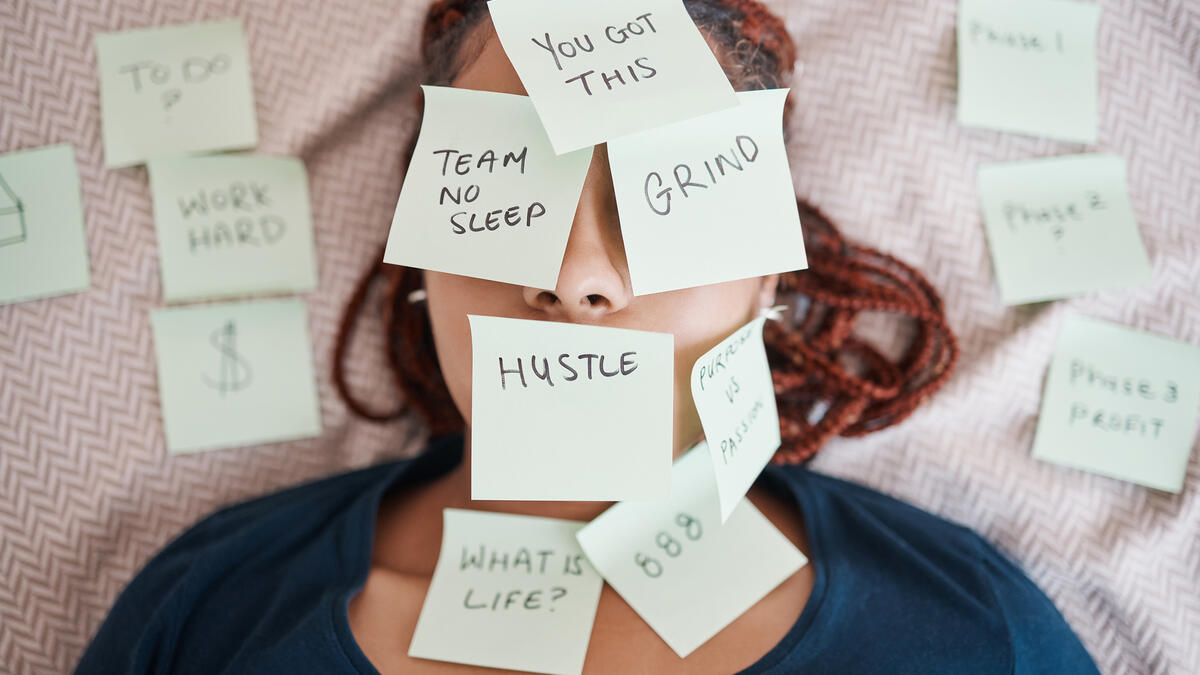
Photo courtesy iStock/Getty Images
The impact of stress on individuals in work and educational contexts poses a significant financial burden, particularly in the workplace, estimated at around $300 billion annually.
And while some stress is to be expected as part of the college experience, according to Christopher P. Neck , the pressure for college students to excel and find a good job is more complex and pervasive than ever before.
Neck, a professor at the W. P. Carey School of Business at Arizona State University, co-authored a paper titled “Effective Stress Management: A Model of Emotional Intelligence, Self-Leadership, and Student Stress Coping” with four other academics Neck’s co-authors include Jeffery D. Houghton, Jinpei Wu, Jeffrey L. Godwin and Charles C. Manz. to explain the complex interplay of emotional intelligence and self-leadership in enhancing students' ability to manage stress effectively.
5 tips for stress regulation
1. Cultivate emotional intelligence: Develop your emotional intelligence by enhancing your ability to perceive, understand and regulate your own emotions.
2. Practice self-leadership: Embrace self-leadership principles to take control of your thoughts, feelings and actions.
3. Engage in positive self-talk: Foster a positive mindset by engaging in constructive self-talk.
4. Utilize stress coping strategies: Equip yourself with effective stress coping strategies to manage academic pressures and life transitions.
5. Foster a growth mindset: Cultivate a growth mindset by embracing challenges as opportunities for learning and personal growth.
The Journal of Management Education published the paper in 2012, and a decade later, the research’s relevance has not only persisted but also gained recognition for its enduring impact on the field.
That’s why it was awarded the 2023 Lasting Impact Award by the Management and Organizational Behavior Teaching Society and Sage Publications. This accolade is awarded to publications that have significantly influenced management education or educators, providing insights that remain relevant and vital over the years. The recognition underscores the article’s substantial influence and role in shaping educational approaches to stress management.
As we approach the presentation of this award at the 51st annual MOBTS Teaching Conference in June 2024 and in recognition of Mental Health Awareness Month , it is poignant to reflect on the developments since the article’s publication and consider the future trajectory of this research area.
ASU News spoke to Neck about how the landscape of student stress has evolved over the years, and what new understandings we need to integrate into our educational systems.
Editor's note: Answers may have been edited for length and/or clarity.

Question: How has stress become more intense for college students over the years, and what don't people understand about what students are dealing with today?
Answer: The adage “You can’t control the wind but certainly can adjust the sails” rings true here. In short, there seems to be a lot more wind facing college students today. Stress among college students has evolved significantly over the years, becoming more intense due to various societal and cultural factors. One prominent contributor is the increasingly competitive nature of academia, with higher expectations for academic achievement and a greater emphasis on career prospects post-graduation. The pressure to excel academically while balancing extracurricular activities, internships and social obligations can be overwhelming.
Additionally, the rise of technology and social media has created a constant state of connectivity, making it challenging for students to disconnect and relax. The pervasive influence of social media also contributes to feelings of comparison and inadequacy, as students often compare themselves to their peers’ seemingly perfect lives portrayed online. Also, the proliferation of social media creates a situation where students are usually multitasking — a problem that increases anxiety and stress.
Furthermore, financial burdens play a significant role in exacerbating stress among college students today. The rising cost of tuition, coupled with concerns about student loan debt and job prospects after graduation, adds additional pressure. Many students also juggle part-time jobs or internships to support themselves financially, further adding to their stress levels. Moreover, issues such as mental health challenges, societal expectations and the uncertainty of the future contribute to the complexity of stress experienced by today's college students. Overall, the multifaceted nature of stressors facing students today highlights the need for comprehensive support systems and effective coping strategies within higher education institutions to help students “adjust the sails.”
Q: In your paper, you specifically name two types of stress students experience: distress and eustress. Can you summarize each type and how it uniquely applies to college students?
A: Distress and eustress are two distinct types of stress that college students commonly experience, each with unique characteristics and implications.
Distress is the negative type of stress, characterized by feelings of overwhelm, anxiety and pressure. In college, distress often arises from academic deadlines, performance expectations, interpersonal conflicts and personal struggles. ... Distress can harm students' mental and physical well-being if left unaddressed, impacting their academic performance and overall quality of life.
On the other hand, eustress is a positive form of stress that arises from challenging but manageable situations. Unlike distress, which is overwhelming and debilitating, eustress is energizing and motivating. In college, eustress can stem from experiences such as starting a new project, preparing for an exam or pursuing personal growth opportunities like joining clubs or participating in extracurricular activities. ... Eustress can enhance students' motivation, focus and performance, helping them thrive academically and personally.
Understanding the distinction between distress and eustress is crucial for college students as it allows them to effectively identify and manage their stressors. By recognizing the difference between overwhelming challenges that may require support and manageable stressors that can enhance performance, students can develop coping strategies tailored to their specific needs. Additionally, fostering a positive mindset and reframing stressors as opportunities for growth can help students harness the power of eustress to successfully navigate the demands of college life.
Q: Your paper also discusses emotional intelligence and emotion regulation. What are these concepts, and how do they apply to this situation?
A: Emotional intelligence refers to the ability to perceive, understand, manage and utilize emotions effectively in various situations. It encompasses self-awareness, self-regulation, empathy and social skills. Emotion regulation, on the other hand, refers to the process of managing and controlling one's emotional responses to different situations.
These concepts are highly relevant for college students and stress management for several reasons. Firstly, college life often presents numerous challenges and stressors, from academic pressures to personal relationships and career uncertainties. Developing emotional intelligence equips students with the skills to navigate these challenges effectively. For instance, self-awareness allows students to recognize their emotional triggers and responses, while self-regulation enables them to manage stress and maintain balance. Empathy and social skills help students build supportive relationships and seek help when needed, fostering resilience and coping mechanisms.
Moreover, emotion regulation strategies play a crucial role in mitigating the negative impact of stress on students' mental health and well-being. By learning to regulate their emotions, students can reduce feelings of anxiety, overwhelm and burnout commonly associated with college life. Effective emotion regulation also promotes adaptive coping strategies, such as seeking social support, engaging in problem-solving and practicing self-care — essential for managing stress effectively.
Q: You and your co-authors suggest that self-leadership is a primary way of dealing with stress. What is self-leadership, and how can students develop stress-regulating strategies?
A: Self-leadership is the process of influencing oneself to establish self-direction and self-motivation for effective performance. It involves adopting specific behavior-focused and cognitive-focused strategies to enhance individual effectiveness. In essence, self-leadership empowers individuals to take control of their thoughts, feelings and actions, facilitating goal achievement and personal growth.
For college students, developing self-leadership skills is paramount for effectively managing stress and navigating the demands of academic life. One way students can cultivate self-leadership is by practicing behavior-focused strategies such as self-observation, self-goal setting, self-reward and self-correcting feedback. Self-observation entails assessing one's behaviors to identify areas for improvement or change, while self-goal setting involves setting specific, challenging and realistic goals to focus one's efforts. Self-rewarding involves creating incentives linked to goal attainment to motivate and energize oneself, while self-correcting feedback entails evaluating failures constructively and redirecting efforts toward positive outcomes.
Additionally, students can develop cognitive-focused self-leadership strategies to reshape their thought processes and enhance their coping abilities. Cognitive strategies include positive self-talk, constructive mental imagery and challenging dysfunctional beliefs and assumptions. Positive self-talk involves fostering optimistic inner dialogues to combat negative self-talk and promote resilience. Constructive mental imagery visualizes success and positive outcomes to bolster confidence and motivation. Challenging dysfunctional beliefs involves identifying and reframing negative thought patterns contributing to stress and adopting more adaptive perspectives.
Q: What do you envision as the next steps in this field of research and practice?
A: Looking ahead, the next frontier in stress management research for college students lies in exploring the intersection of emotional intelligence, self-leadership and holistic well-being. While our model provides valuable insights into the mechanisms through which these factors influence stress coping, there is still much to uncover in terms of individual differences, contextual influences and long-term outcomes. Future research could delve deeper into the efficacy of specific intervention programs tailored to enhance college students' emotional intelligence and self-leadership skills, evaluating their impact on academic performance, mental health outcomes and overall resilience.
Moreover, as technology continues to reshape the landscape of higher education, there is a growing need to explore innovative approaches to stress management that harness digital platforms and virtual resources. From mobile apps and online support networks to virtual reality-based interventions, the possibilities for leveraging technology to promote student well-being are vast.
For instance, I’m currently working on a study where students use a daily app on their smartphones to record their self-talk during a particular time each day. The hope is that by helping students become more aware of their mental processes, they can learn to realize when such self-dialogue is creating stress and how they can change this dysfunctional self-talk to less stress-provoking.
More Business and entrepreneurship

Ribbon cutting celebrates opening of Schwab Foundation Financial Access and Research Lab
“We used to have to do this in a closet,” quipped finance students as they demoed the new equipment in the Charles Schwab Foundation Financial Access and Research (FAR) Lab, housed in Arizona State…

Thunderbird at ASU alumnus Marshall Parke to deliver keynote at spring 2024 convocation
Marshall Parke, distinguished alumnus of the Thunderbird School of Global Management at Arizona State University and global entrepreneur, will deliver the keynote address at Thunderbird’s convocation…

How sports analytics is changing the game
Have you ever wondered why your favorite basketball team loses season after season? Or why other teams perform well? Height plays a huge role in the NBA — the average NBA player is 6 feet 6 inches…

- Why Study Abroad?
- Program Search
- How to Apply?
- Funding Your Studies
- Visa Application
- Book Accomodation
- Select Health Cover
- Pre Departure
- Study in Australia
- Top Australian Universities
- Intakes in Australia
- Study Costs in Australia
- Australian Student Visa
- Student Work Opportunities
- Study in Canada
- Top Canadian Universities
- Intakes in Canada
- Study Costs in Canada
- Canadian Student Visa
- Study in Ireland
- Top Ireland Universities
- Intakes in Ireland
- Study Costs in Ireland
- Ireland Student Visa
- Study in the UK
- Top UK Universities
- Intakes in the UK
- Study Costs in the UK
- UK Student Visa
- Study in the USA
- Top US Universities
- Intakes in the USA
- Study Costs in the USA
- US Student Visa
- Gradstar University Partners
- Gradstar School Partners
- Our Student Success Consultants
Build a Productive Weekend Routine for Students
- November 8, 2023
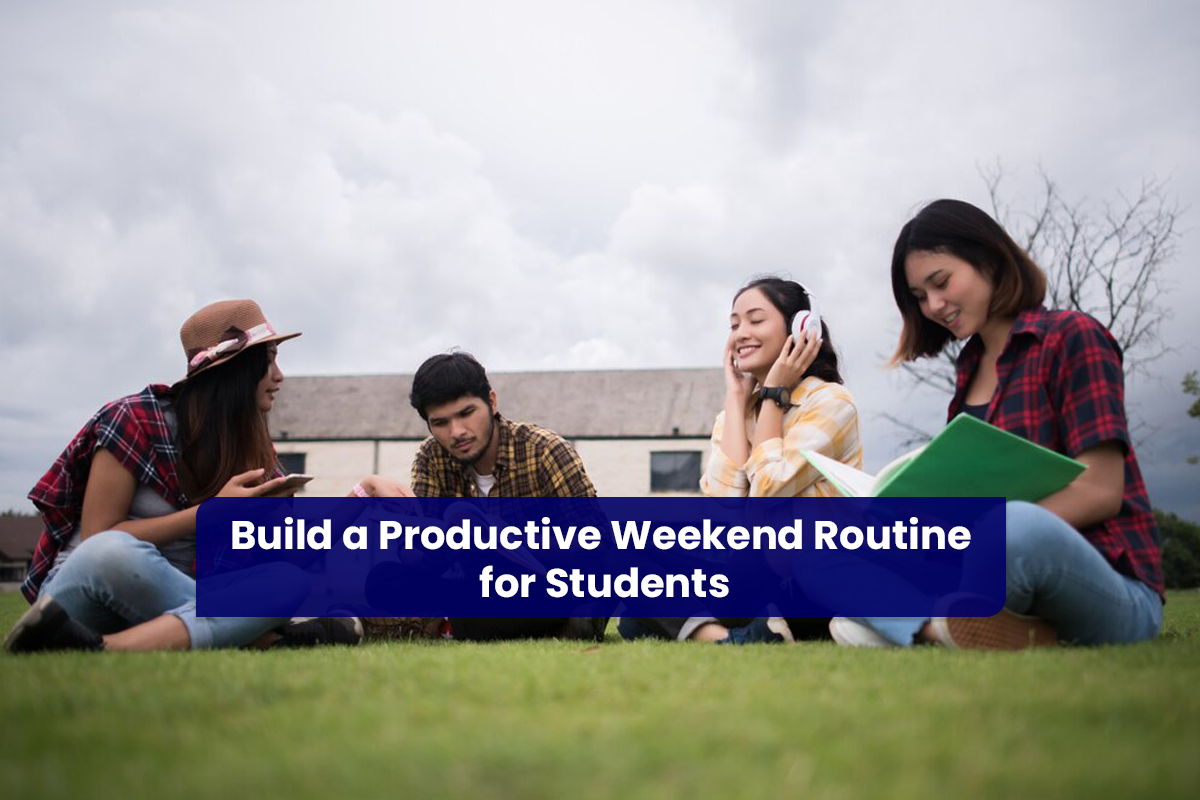
Starting the study abroad journey is both exciting and demanding on you. The lively campuses, different cultures, new friendships and of course your classes definitely keep you busy. But with so many things going on, the weekend routine of students can end up all over the place. How can you balance your academic life, getting enough rest, and making the most of your time abroad, in two days?
In this blog, we’ll unfold the steps on how to be productive on weekends. So, in the spirit of making the most of the time we have, let’s get going!
7 Ways to Set Up a Good Weekend Routine for Students
We know the feeling of planning all the things we want to do over the weekend only to spend most of it sleeping and watching Netflix. Monday becomes the scariest day of the week then, because everything you needed to do, you did not get to. Which is all the more reason why balancing work and play is the key to a productive weekend!
After a week spent in classes, quizzes, and assignments, it’s natural to feel exhausted. But you also don’t want to fall behind on the recommended reading you have to do for your next quiz or the assignment due soon. With proper time management, though, you can manage both your deadlines and recharge for the week ahead!
1. Focus Your Learning to Use Time Efficiently
The Pomodoro technique may sound familiar to students desperate to find study hacks that work – and yes, it does work. This technique involves learning for 25 minutes and then taking a short 5-minute break. In this way, you are able to really focus, retain, and remember your learning.
While you learn something new, your brain is using its short-term memory. But short-term memory is finite – the more information you pour in, the less will actually stick. Imagine it like a bucket of water overflowing the more water you pour inside.
Instead, the short bursts of complete focus with a break in between gives your brain time to convert short-term to long-term memory. This way you are able to develop your learning like a building with a solid foundation rather than a Jenga tower!
In fact, taking a break from focusing allows your brain to start making meaningful connections between the information you learned. Because it isn’t diverting all its resources towards what is immediately in front of it, your brain takes its time to make sense of all this new information.
Have you ever had a sudden realization in the middle of brushing your teeth or in the shower? This is why! Your idle brain is still working, processing what you did all day and putting it together. The 5-minute breaks in between study sessions helps you learn in a way that will last beyond your next test.
After about four 25-minute study sessions, take a longer break of 15 to 30 minutes. This is an excellent time to get a snack, go for a walk, watch something fun on YouTube.
By breaking your learning up like this, you are using less time to do more.
Think about it – we all know what it’s like to sit at a desk for hours and feel like we remember nothing the next day. Cramming is not great for your short- or long-term memory!
Using the Pomodoro technique, you not only make time to work, but time to relax and play too. The latter is an equally important part of how to have a productive weekend!
2. Rise and Shine Early(ish)
There is a scientific case for how sleep helps productivity. Your brain doesn’t simply turn off when you go to bed. As you sleep, your brain is sorting through what you learned in the day and converting it into long-term memory.
This is why you might realize that you don’t actually remember most of what you crammed during an all-nighter. Sleep deprivation not only impacts your memory retention, but also your ability to focus. You’re far more likely to make mistakes during a test if you didn’t sleep before it. So, make sure you get your beauty and brain sleep in, not just for productive weekends but productive weeks overall!
And as much as we are strong advocates for sleeping in during weekends, we do want to make sure you’re getting the right sort of sleep. Staying up late into the night watching anime or hanging out with friends is a rite of passage for university students. But if you want to stick to a productive weekend routine for students, we don’t recommend making this a habit.
This is because of how your body clock – or circadian rhythms, if you want to get fancy – works. During the daytime, receptors in your eyes detect daylight and send signals to your brain that it’s time to be alert. If you sleep too late into the day, you’re missing this optimal window for productivity!
Here’s our recommendations for good sleep practices to make the most of your day:
• Hold off on meals, snacks, drinks and such before bedtime. Otherwise, you might stay up while your body digests or wake up in the middle of the night to go to the loo
• No caffeine before bed. This is pretty self-explanatory, since caffeine can stay in your system for hours after drinking. You might only find yourself falling asleep when the birds outside are waking up
• Put the devices down. Your phone, laptop, iPad screen etc. all produce blue light – a component of visible light that tricks the brain into thinking it’s daytime. As a result, the longer you keep staring at your screen, the more your brain forces itself to stay awake and alert. If you have to be on your devices, to study or because you really can’t do without some extra watch hours, switch the colour temperature of your device to a yellow, blue-light filtering setting. We also recommend blue-light filtering glasses!
3. Go and Explore the World Outside Your Dorm
After a week of intense classes, disengaging from the rush of tests and deadlines can help you relax. This eases you into the weekend. Perhaps you can take a stroll in a nearby park or discover the scenic locations of your campus. Enjoy the change of scenery and make the sights and sounds of this foreign country feel like home.
This will help you to overcome cultural shock as well. The more familiar you become with your new home, the more comfortable you will be here. Over time, any anxiety that comes from your fear of getting lost or being in a strange new place will give way to a feeling of belonging.
The anxiety and stress from being in a new place, the homesickness of being away from the familiar – all of this can be unproductive towards your weekend routine as a student. It might feel easier to stay in bed or hide away indoors. But the more comfortable you feel in your surroundings, the easier it will be for you to make the most of your time abroad.
Many experts say the afternoon is an opportunity for exploration. If you are up for going out, visit local landmarks, museums, or markets. And yes, as we discussed in the previous section, going out during the daytime helps you get all that great, naturally-occurring blue light. This is a very natural way to wake up your biological system for the day!
Take it a step at a time and before you know it, you’ll be the tour guide showing family and friends around when they come by to visit!
4. Plan Your Weekend Must-Do’s
Did you put off your laundry for the weekend? Is there an assignment due a couple of weeks later that you want to get a head-start on? Write it all down – use a planner, journal, calendar, or your phone.
By mapping out what you need to do, you have a visual reminder and structure to follow. Otherwise, it can get all muddled up in your head, and you’re more likely to forget.
There’s also a scientific reason for why to-do lists work. Checking off a task brings a sense of accomplishment and reward – this happens because of a spike of a brain-chemical called dopamine . This dopamine is the secret to your motivation and productivity!
Your brain learns to anticipate a reward when you’re checking off things on your to-do list, and releases dopamine that keeps your focus and motivation levels high. So, take advantage of this piece of brain science and use to-do lists to your advantage!
A bit of warning though – make sure the items of your list are realistic. “Do the laundry”, “go grocery shopping”, “finish chapter 5 for next week” – these are all realistic to-do list items. “Finish assignment” might not be – it’s too broad of a task, and can have the opposite effect of motivating you if you fail to check it off. So be realistic and break your bigger tasks, like “chores”, into smaller ones, like “clean the kitchen sink” and “take out the trash”.
5. Get in Some Exercise
If you are an activity-lover, you can join a local sports club or hit the gym with friends. And even if you aren’t, a brisk walk and some indoor exercises can still make a difference. Studying abroad is not just about hitting the books constantly. Looking after yourself is a key part of the ensuring your success as an international student.
There is plenty of scientific evidence supporting the role of exercise in the weekend routine for students. Physical activity can:
• Keep you in a great mood as you navigate student life
• Reduce your stress levels
• Improve the quality of your sleep
• Help you focus on your studies
• Maintain better energy and stamina through the day
• Keep your motivation up for a busy week
6. Get to Know Your Community
Why not plan a gathering with classmates? Try a potluck dinner where everyone brings a dish from their home country. It’s not just a meal – it’s an opportunity to get to know your new friends, their lives, where they come from.
Our introvert readers may think this is an impossible task. But if someone reaches out to you to hang out, take up their offer. Socialization and community also have scientifically proven benefits for mental and emotional health, productivity, and motivation. Take it little by little – lunch with two or three people, bowling with a group of five, a group trip to the cinema.
It makes things easier that universities and on-campus residences often host activities that help students connect with each other. This is typically the case wherever you are in the world, whether you’re studying in the USA or across the pond. We encourage you to sign up for these, even if you’d rather spend the free couple of hours sleeping in. You never know – you might find yourself companions for your next adventures right here!
Try to create memories and a feeling of community. Experiences can be a lot more fun with people to share them! You can:
• Join a language exchange meetup, where you can practice your language skills
• Invite roommates or friends for board game nights or trips to the cinema
• Join a sports team or sign up for clubs or societies to bond with people over similar interests
7. Make Time for Things You Enjoy
When assignment pressure kicks off it might seem like doing anything other than gluing yourself to your laptop is a bad idea. And if you know our old friend procrastination well, you also know the feeling of losing hours of time doing something you don’t even enjoy only to speed-run a paper minutes before the deadline.
Trust us, making time for your hobbies and yourself helps with that. Treat yourself to a cozy breakfast at the neighbourhood café, schedule a call home with family and friends, read a book. Spend late afternoons engaging in a hobby or attending a local event. Why not try out things like painting classes, soccer games, or poetry reading sessions?
Look into the places on campus or nearby offering activities you love or want to try. A one-day class or workshop could turn into a lifelong passion. Trying new things and developing new skills and habits don’t just help make life more interesting. They have learning, health, and brain benefits too!
Learning new things is like exercise for your brain. Even exploring new ways of interacting with the world has this effect – like learning how to ride a bike. As your brain wires new experiences and learning into it, it sharpens its other functions too. This includes memory, the ability to focus, and how well you learn. Yes, this includes all kinds of learning, including what you’ll do in class! And all of these are pretty important for the average university student!
Besides, balancing doing the things you love to do with your academic commitments helps you lead a healthy work-life balance. You are in better spirits and less likely to fall down the procrastination rabbit hole. So make time for yourself in your productive weekend routine for students!
Benefits of Maintaining a Productive Weekend Routine for Students
A productive weekend can bring about numerous benefits that extend beyond the immediate satisfaction of completing tasks. Here are some advantages:
1. Reduced Stress:
When you tackle important tasks over the weekend, you start the following week with a lighter load. This can significantly reduce stress and make the upcoming week more manageable.
2. Increased Productivity:
A productive weekend for students sets a positive tone for the week ahead. By accomplishing tasks and goals, you build momentum and carry that proactive energy into your work, studies, and student life.
3. Improved Time Management:
You need effective time management skills to plan and execute a productive weekend. This skill naturally spills over into your weekday routines. It helps you make the most of your time and prioritize tasks effectively.
4. Enhanced Well-Being:
Accomplishing tasks and engaging in activities that bring you joy can bring your overall well-being up too. It can be discovering a new hobby, exercising, or spending quality time with loved ones. These activities can boost your mood and satisfaction.
5. Better Work-Life Balance:
A productive weekend helps to keep a healthier balance between your work or academic responsibilities and your personal life. It ensures that you dedicate time not only to your professional or academic pursuits but also to relaxation and recreation.
6. Goal Achievement:
If you set specific goals for the weekend and accomplish them, you’re actively working towards your short-term objectives. This sense of achievement will push you a step forward toward personal growth and motivation.
7. Increased Confidence:
Meeting deadlines, completing tasks, and achieving goals over the weekend contribute to a sense of accomplishment. This, in turn, helps you keep up your confidence and motivation as you take on the challenges of studying abroad like a pro.
8. Quality Time with Others:
A productive weekend doesn’t necessarily mean all work and no play. It can involve spending quality time with friends and family. Meaningful social connections contribute positively to your mental and emotional well-being. In turn, this has an effect on how you’re performing in school!
9. Personal Growth:
Engaging in activities that challenge you or contribute to your skills and knowledge builds personal growth. Whether it’s learning a new skill, pursuing a hobby, or completing a personal project, productive weekends can be transformative.
10. Improved Sleep Quality:
Following a weekend routine for students can positively impact your sleep patterns. When you accomplish your tasks on time and feel a sense of control over your responsibilities, it can lead to better sleep quality. And we already know why sleep is a big deal for learning!
What a Good Weekend Routine for Students Looks Like
Now you know all the benefits of following a weekend routine for students abroad and the science-backed benefits of our tips. What a “productive Saturday” means for you can look very different compared to someone else, but here’s ideas to get you planning.
Morning Routine
When you wake up early, your morning routine is up for a fresh start. So, set a wake-up time with a sufficient night’s sleep of 7-8 hours. Aim for consistency to regulate your body’s internal clock. As you wake up, resist the temptation to check your phone immediately. Instead, take some time to do some light stretches to get your blood pumping, take some focused breaths. This sets a positive tone for the day.
Then, you can engage in a morning exercise routine, whether it’s a quick jog, yoga, or a home workout. Physical activity boosts energy levels and enhances mood. Following exercise, have a nutritious breakfast that includes a balance of protein, carbohydrates, and healthy fats. This gives your brain and body the fuel you need for a productive weekend routine for students.
Daytime Routine
Daytime is full of activities and engagements. Plan your study sessions with a clear focus on tasks and goals. Break down the big things you need to do into smaller to-do list items. Use techniques like the Pomodoro method—work for a set period, then take a short break. This helps maintain concentration and prevents burnout. Organize and schedule your tasks on the basis of priority.
Try to take breaks throughout the day for 15-20 minutes. This will help you prevent burnout and maintain mental clarity. Use these breaks to do something enjoyable or relaxing, such as going for a walk, listening to music, or chatting with friends. Additionally, allocate time for personal tasks, such as running errands or pursuing hobbies.
Evening Routine
As the evening approaches, engage in activities that signal to your body and mind that it’s time to wind down. This could include reading a book, practicing mindfulness or meditation, or taking a warm bath. Avoid screen time at least an hour before bedtime to promote better sleep.
As the last day of the weekend knocks, take some time in the evening to plan and organize for the next day. Review your schedule, prioritize tasks, and set goals. Lay out your clothes, gather any materials you’ll need, and make a to-do list. This gives you a smooth start to the next day. Also, you can mentally relax in the evening, knowing you are ready for the week ahead.
Remember that the goal is to personalize the routine to your requirements and tastes. There is no one-size-fits-all template for productive weekend routines for students. However, there should in general be enough time for you to meet your academic commitments, as well as make time for yourself.
Effective Weekend Studying Strategies
• Set clear goals for the weekend study sessions.
• Create a study schedule and allocate time blocks for different tasks.
• Prioritize tasks and deadlines and tackle systemically.
• Minimize distractions by turning off notifications and finding a quiet study space.
• Use active learning techniques like summarizing information and teaching concepts to yourself.
• Take strategic breaks, following methods like the Pomodoro Technique.
• Review and reinforce material covered during the week.
• Keep study materials organized for easy access.
• Use technology to boost work while minimizing distractions.
• Don’t study the same thing for too long to keep your brain actively engaged.
• Consider collaborating with peers in study groups for diverse perspectives.
• Stay hydrated, have nutritious snacks, and incorporate light physical activity.
• Track progress and celebrate small victories for motivation.
• Reflect on achievements and areas for improvement to plan for the upcoming week.
Tips for Maintaining Consistency
To be consistent, you must create a routine that fits your priorities and set reasonable goals . Break down bigger activities, utilize reminders, and be flexible to unexpected developments. Accountability partners, regular reflection, and recognizing small achievements all help the process.
Reduce distractions, incorporate work into everyday routines, and learn from setbacks. Understand the “why” behind your goals and be kind to yourself, as consistency is about progress more than perfection.
Visual reminders, tracking your progress, and frequent reviews help you to be on track. If you can create a balance by adopting these habits into your daily routine, you can keep them consistent. Learning these tips for a relaxed yet productive weekend will help you throughout life.
Rounding Up
Your weekend is not just a pause. While studying abroad, practicing the weekend routine for students can boost your academic and personal success. Never hesitate to develop your student experience by engaging with local cultures, interesting study sessions, and self-care opportunities. Every weekend is an opportunity to add value to your journey. Your weekends matter; make them count.
Enquire Now
Co-Design Your Study Abroad Journey
By providing an email address. I agree to the Terms of Use and acknowledge that I have read the Privacy Policy .
DepEd to issue ‘more precise’ guidelines on students’ homework policy

Education Secretary Leonor Briones. INQUIRER file photo
MANILA, Philippines — The Department of Education (DepEd) will soon release a “more precise” guideline on regulating the amount of homework given to students, Secretary Leonor Briones said Monday.
Briones stressed DepEd’s current guidelines state that no homework should be given on weekends, while teachers are advised to limit assignments during weekdays.
“The existing policy is no homework on weekends. But we are also encouraging our teachers to limit the homework during weekdays especially on particular subjects,” Briones said during a press conference.
“And we’re going to come out with additional guidelines, na magiging more precise ‘yung guidelines, on whatever homework teachers might impose during weekdays and on what subjects,” she added.
Briones earlier expressed support to the proposed no-homework policy from kindergarten to high school, saying it would help students achieve a school-life balance.
READ: DepEd: No-homework plan to help students attain school-life balance
DepEd Undersecretary Diosdado San Antonio said researches state younger students should have lesser homework compared to older students and this will be indicated in the guidelines the agency will soon release.
“The strand is drafting a homework policy for DepEd. We will capture what the secretary has mentioned,” San Antonio said.
“The literature is saying that younger kids should have less and the kids in the higher grades like senior high school may be given more homework,” he added.
Several measures proposing a no-homework policy were filed at the House of Representatives and the Senate.
Deputy Speaker Evelina Escudero’s bill wants to eliminate homework and limit school activities to the campus while Quezon City Rep. Alfred Vargas’ bill wants to stop teachers from giving homework to students during the weekends. Senator Grace Poe has filed a similar bill to Vargas’. /jpv
Subscribe to our daily newsletter
Disclaimer: Comments do not represent the views of INQUIRER.net. We reserve the right to exclude comments which are inconsistent with our editorial standards. FULL DISCLAIMER
© copyright 1997-2024 inquirer.net | all rights reserved.
We use cookies to ensure you get the best experience on our website. By continuing, you are agreeing to our use of cookies. To find out more, please click this link.
The University of Chicago The Law School
Law school celebrates 2024 reunion weekend.

Alumni and their families enjoyed a busy line up of activities at the 2024 Reunion Weekend this spring. The event kicked off on May 2 with the Elisa Fernandez Banquet hosted by the Latinx Law Students Association and concluded on May 5 with a Chicago Cubs game at Wrigley Field Rooftops. This year’s reunion celebrated the classes of 1969, 1974, 1979, 1984, 1989, 1994, 1999, 2004, 2009, 2014, and 2019.

IMAGES
VIDEO
COMMENTS
SLU felt a three-day weekend would be beneficial to improving mental health. Therefore, three-day weekends should become normalized. They should not be seen as a "break," nor should professors be allowed to assign work over these days off. Giving students a three-day weekend will increase their free time, allowing them to practice better ...
• Greater stress: 56 percent of the students considered homework a primary source of stress, according to the survey data. Forty-three percent viewed tests as a primary stressor, while 33 percent put the pressure to get good grades in that category. ... Students were more likely to drop activities, not see friends or family, and not pursue ...
A weekend with no homework would help them to be fresh and ready on Monday morning. Weekend assignments tend to be longer and more difficult. The students have a difficult day with classes, practices, and going to school. By Friday, (test day) they are near exhaustion. Most tests are given on Fridays.
Table 2 reports average weekend study time for fifth and sixth grade non-GATE and GATE students. The responses reveal that non-GATE 5 th grade students spend on average 39 minutes studying during weekends. The study time is longer for 6th grade students who report studying on average 41 minutes.
For older students, Kang says, homework benefits plateau at about two hours per night. "Most students, especially at these high achieving schools, they're doing a minimum of three hours, and it's ...
Keywords: homework, stress, mental health The outcomes of adolescent mental health is a threat to students' health and wellbeing, more so than it ever has been in the modern era. As of 2019, the CDC reported a nearly 40. percent increase in feelings of sadness or hopelessness over the last ten years, and similar.
As expected, students' time use differed substantially on weekends, when little or no time was spent in school on classroom or co-curricular activities. Adolescents increased their nocturnal time in bed for sleep on weekends to about 9 hours, and also spent substantially more time on homework, media use, hanging out with friends, and face-to ...
How To Avoid Homework Stress. Here are 10 tips to help your child learn how to make homework less stressful. 1. Stick to a Schedule. Help your child plan out his or her time, scheduling time for homework, chores, activities, and sleep. Keep this schedule handy so your child knows what he or she should be working on, and when.
Here are some ideas to consider in getting you started: exercise, such as doing yoga or walking. a bath or Jacuzzi soak. a massage. a hobby, such as cooking or creating art. meditation or prayer ...
This blog will cover some techniques you can utilise to help reduce and manage your stress and anxiety levels during assignment periods and leading up to your exams. ... Jump onto their global community and chat with other students that get it. Download Talk Campus . Events. Midday Mindfulness 29 May - 24 Jul 2024. Weekly Rolling Group 29 May ...
You can also de-stress by indulging in a hot bath or relaxing with calming music. Effective stress management techniques can include writing, mindfulness or meditation, and socializing with loved ones. Make sure you eat healthily, exercise frequently, get adequate sleep, and take breaks to refuel.
* Greater stress: 56 percent of the students considered homework a primary source of stress, according to the survey data. Forty-three percent viewed tests as a primary stressor, while 33 percent ...
The result shows that students with assignments during weekends were able to cope and be at par with the without assignment group Garia and Salend (1995) and Letterman (2013), in which homework or ...
This shows that giving assignment on weekends is a boon to students' performance. Discover the world's research. ... and fringe benefits. Stress coping was high, specifically in their personal ...
Here are a few things kids can try to help them unwind: Outdoor Activities: Spending time outdoors, whether playing sports or simply running around, can help reduce stress and improve mood. Creative Arts: Activities like drawing, painting, or crafting allow for creative expression and can be very soothing.
Encourage your child to start their homework as early as possible. Help them review their assignments, make a plan for what needs to be completed, and then dive in. Naturally, children are more tired later in the evening which can lead to more stress. 4. Encourage Breaks. If you can see your child becoming frustrated or overwhelmed by their ...
Key Takeaways: Homework on weekends may lead to stress, decreased academic performance, and health issues for students. Quality family and leisure time are compromised due to weekend assignments. Experts suggest that excessive homework is counterproductive, recommending less intensive tasks that encourage reading and exploration.
It is certainly a good idea to have a plan, as long as it remains adaptable. 6. You are not alone. The most powerful tool anyone has when dealing with these stressful situations is the support of family and friends. Let people around you know when exams are coming up or that your next big assignment deadline is not far away.
O ver the past decade, the prevalence of mental health problems among college students has risen steadily. In our national Healthy Minds Study, which surveys over 800,000 students, we have seen these challenges go from bad to worse.Collected annually at hundreds of US colleges and universities, the data reveals a significant increase in symptoms of depression (22 percent in 2012 to 44 percent ...
To prevent this from happening, students should not receive assignments on the weekends. This can happen by teachers planning their lessons out each week, so the content does not spill into the weekend. ... Stanford News even reported that homework creates stress. In fact 56% of student stress is caused by homework. 33% is caused by the worry ...
Hypothesis 1 (path 1): Given that stress load always occurs as a duality—beneficial if it is functional for coping, or exhausting if it puts a strain on personal resources [] - we consider two variables for stress load: functional stress and dysfunctional stress.In order to reduce the length of the daily surveys, we focused the measure of recovery only on the most obvious and accessible ...
The impact of stress on individuals in work and educational contexts poses a significant financial burden, particularly in the workplace, estimated at around $300 billion annually. And while some stress is to be expected as part of the college experience, according to Christopher P. Neck, the pressure for college students to excel and find a good job is more complex and pervasive than ever before.
There is plenty of scientific evidence supporting the role of exercise in the weekend routine for students. Physical activity can: • Keep you in a great mood as you navigate student life • Reduce your stress levels • Improve the quality of your sleep • Help you focus on your studies • Maintain better energy and stamina through the day
Briones stressed DepEd's current guidelines state that no homework should be given on weekends, while teachers are advised to limit assignments during weekdays. ADVERTISEMENT "The existing ...
Alumni and their families enjoyed a busy line up of activities at the 2024 Reunion Weekend this spring. The event kicked off on May 2 with the Elisa Fernandez Banquet hosted by the Latinx Law Students Association and concluded on May 5 with a Chicago Cubs game at Wrigley Field Rooftops. This year's reunion celebrated the classes of 1969, 1974, 1979, 1984, 1989, 1994, 1999, 2004, 2009, 2014 ...